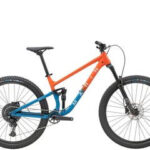Transporting your bicycles safely and conveniently is paramount for any cyclist, whether you’re embarking on a weekend adventure, hitting the trails, or heading to a race. While various bike transport solutions exist, receiver hitch bike racks stand out as arguably the Best Receiver Hitch Bike Rack option for many. They offer a robust, secure, and user-friendly way to carry your precious bikes without the hassles of roof racks or the potential for vehicle damage associated with trunk-mounted systems.
However, the vast array of hitch bike racks available on the market can make choosing the ideal one a daunting task. From platform and hanging racks to vertical and swing-away models, each offers a unique set of features and benefits. Navigating through the specifications, weight limits, compatibility, and price points requires careful consideration.
At usabikers.net, we understand the importance of reliable gear and the need for informed purchasing decisions. That’s why we’ve rigorously tested and evaluated numerous hitch bike racks to bring you a comprehensive guide to the best receiver hitch bike racks of 2024. Our expert team has assessed each model based on critical factors such as ease of use, durability, bike security, versatility, and overall value.
Whether you’re a seasoned mountain biker with a stable of rigs, a family looking to transport bikes for everyone, or an e-bike enthusiast needing a rack capable of handling heavier loads, our guide will help you find the best receiver hitch bike rack to meet your specific needs and budget. We’ve compiled our top recommendations, highlighting the strengths and weaknesses of each rack to empower you to make a confident and informed choice.
To further assist you, we’ve included a detailed comparison chart to easily compare product specifications and a comprehensive buyer’s guide that dives into the key considerations when selecting a hitch bike rack. We’re here to answer your questions and ensure you find the perfect solution for transporting your bikes safely and securely in 2024 and beyond.
The Best Hitch Bike Racks of 2024
Best Overall Hitch Bike Rack
Thule T2 Pro XTR
Check Price at REI
Check Price at Amazon
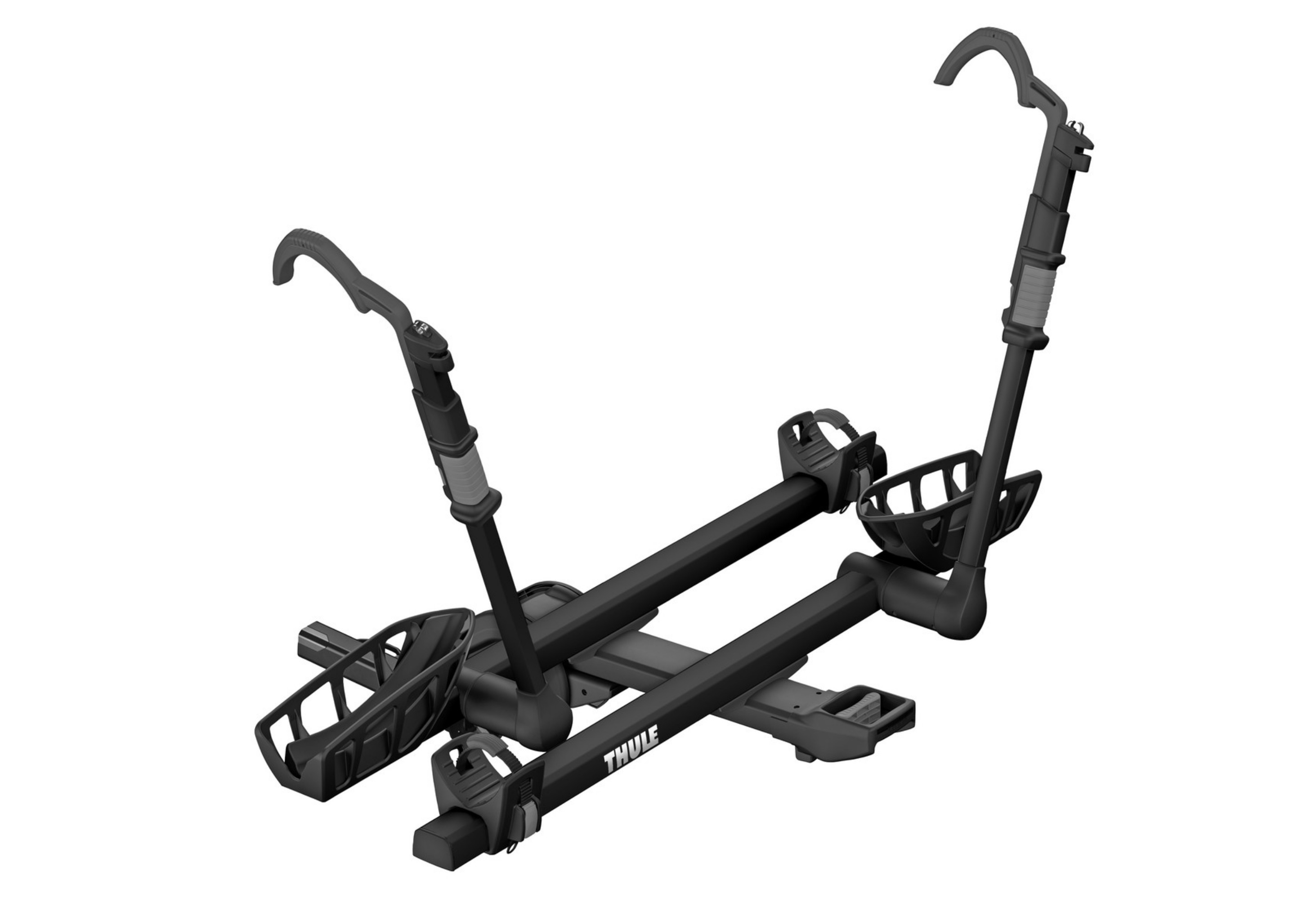 The Best Hitch Bike Racks of 2024
The Best Hitch Bike Racks of 2024
Key Specs:
- MSRP: $750
- Bike Capacity: 2 (expandable to 4 with add-on, 2” version only)
- Receiver Compatibility: 1.25” and 2”
- Rack Weight: 52 lbs
- Per Bike Weight Limit: 60lbs
- Maximum Wheelbase: 50” (1,270mm)
- Maximum Tire Width: 5”
- Wheel Size Compatibility: 20” to 29”
- Security Features: Integrated locking hitch knob and cable locks
Pros:
- Effortless installation and removal process
- Simple and intuitive bike loading mechanism
- User-friendly tilt release system
- Integrated locks for both the rack and bikes
- Convenient transport wheels for easy maneuverability
Cons:
- Higher price point compared to some competitors
- Bulky design requiring considerable storage space
The Thule T2 Pro XTR represents the culmination of years of refinement in Thule’s T2 series, solidifying its position as a top-tier hitch mount tray rack. While maintaining the core strengths of its predecessors, the Pro XTR incorporates subtle yet impactful updates that enhance user experience and convenience. Although the Kuat Piston Pro X might edge it out as the absolute pinnacle of hitch racks, the Thule T2 Pro XTR strikes a more accessible balance between premium features and overall cost, making it a compelling choice for a broader range of cyclists.
Installation and removal are remarkably swift and straightforward thanks to the rock-solid, tool-free AutoAttach system. This system not only secures the rack firmly within the hitch receiver, eliminating wobble, but also includes a locking mechanism for added security. A thoughtful touch is the inclusion of integrated wheels, making it surprisingly easy to move the rack in and out of storage, despite its substantial weight. The large, easily accessible tilt-release handle allows for effortless folding and tilting, even when juggling a bike in one hand.
Bike loading is equally intuitive and efficient. The wide front tire trays, combined with user-friendly front wheel hooks and a ratcheting rear wheel strap, ensure bikes are held securely without any frame contact. This is crucial for protecting delicate frame finishes, especially on carbon fiber bikes. The T2 Pro XTR’s versatility is further highlighted by its tool-free side-to-side tray adjustments, generous spacing between bikes, and compatibility with a wide range of bike types. It accommodates tires up to 5 inches wide, wheel sizes from 20 to 29 inches, and wheelbases up to 50 inches (1,270mm). Furthermore, its robust 60 lb per-bike weight capacity makes it suitable for even heavier e-bikes.
Security is well addressed with the integrated AutoAttach knob that locks the rack to the vehicle and retractable cable locks housed within the front wheel clamps, offering a basic level of bike security. While these integrated locks are convenient for quick stops, for extended periods or in higher-risk areas, we recommend supplementing them with a more robust standalone bike lock. The Thule T2 Pro XTR is available in both 2” and 1.25” receiver sizes, and for those needing to carry more bikes, a T2 Pro XT 2-bike add-on ($500) is available for the 2” version, increasing capacity to four bikes.
The primary drawback of the Thule T2 Pro XTR, common to most hitch-mounted tray racks, is its bulky size. Storing it when not in use can be somewhat cumbersome. Despite this, the Thule T2 Pro XTR remains a top choice, offering a durable, versatile, and remarkably user-friendly solution for transporting your bikes safely and securely.
 Thule T2 Pro XTR
Thule T2 Pro XTR
Getting ready to ride while testing the Thule T2 Pro XTR. (photo/Jeremy Benson)
Best Budget Hitch Bike Rack
Rocky Mounts MonoRail
Check Price at Backcountry
Check Price at Amazon
 The Best Hitch Bike Racks of 2024
The Best Hitch Bike Racks of 2024
Key Specs:
- MSRP: $500
- Bike Capacity: 2 (expandable to 3 with add-on, 2” receiver only)
- Receiver Compatibility: 1.25” and 2”
- Rack Weight: 45 lbs
- Per Bike Weight Limit: 60 lbs
- Maximum Wheelbase: 36” up to 50” (1,270mm)
- Maximum Tire Width: 5”
- Wheel Size Compatibility: 20” to 29”
- Security Features: Locking hitch pin and cable lock included
Pros:
- Appealing price point for a feature-rich rack
- Accommodates a wide range of bike styles and sizes
- High 60 lbs per bike weight capacity
- User-friendly operation
Cons:
- Plastic lock pods on included security features
- Sits relatively close to the vehicle, potentially requiring a hitch extension for some vehicles
- May not be compatible with certain muffler designs due to heat exposure
The Rocky Mounts MonoRail distinguishes itself as a standout value proposition within the tray hitch rack category. It delivers performance on par with more expensive competitors while significantly undercutting them in price. While the $500 price tag may not qualify as ‘cheap’, the MonoRail’s performance and features justify the investment, outperforming less expensive models we’ve tested and making it arguably the best receiver hitch bike rack in its price range. Its ease of use, versatility, and proven durability make it a smart choice for budget-conscious cyclists who don’t want to compromise on quality.
The MonoRail employs folding front wheel trays and user-friendly hook-shaped clamp arms, ensuring compatibility with a vast spectrum of bike types. From 5-inch wide fat bike tires to narrow road bike treads, and wheel sizes ranging from 20 to 29 inches, this rack handles it all. Rear wheels are secured with reliable ladder straps, and extenders are even included to accommodate fat bike tires right out of the box. With a robust 60 lbs per-bike weight capacity and tray adjustability for wheelbases between 36 and 50 inches (1,270mm), the MonoRail comfortably carries most bikes, excluding only the smallest kids’ bikes or exceptionally long mountain bikes. Lateral tray adjustability further minimizes bike-on-bike interference, even with bikes featuring drop handlebars.
The remote tilt release handle is thoughtfully positioned and easy to operate, facilitating effortless rack folding and tilting, even when fully loaded with bikes. Included hitch pin and cable locks, with convenient keyed-alike lock pods, offer a measure of security against opportunistic theft. Long-term durability is a proven strength of the MonoRail. One of our team members has used this rack for over five years, converting it to a BackStage Swing Away model, and it continues to perform reliably with only minor cosmetic rust developing. For increased carrying capacity, Rocky Mounts offers a 1-bike add-on (2-inch receiver size only) to expand to a 3-bike capacity.
Given its competitive price, the MonoRail has surprisingly few drawbacks. The most notable limitation is the plastic construction of the lock pods for the hitch and cable locks. These could be more vulnerable to breakage compared to metal alternatives. We recommend considering an upgrade to more robust locking mechanisms and possibly supplementing with a heavy-duty chain lock for enhanced security. The MonoRail also positions bikes relatively close to the rear of the vehicle, potentially requiring a hitch extension to prevent handlebar contact on some vehicle models. A minor incompatibility may arise with certain vehicles that have rearward-facing mufflers, as the exhaust heat could potentially melt plastic components. However, this issue seems to be relatively uncommon.
Overall, the Rocky Mounts MonoRail delivers exceptional performance and versatility that surpasses its price point, solidifying its position as the best receiver hitch bike rack for budget-conscious buyers. For those seeking the same excellent rack with enhanced vehicle access, the Rocky Mounts BackStage integrates the MonoRail directly onto a convenient swing-away arm.
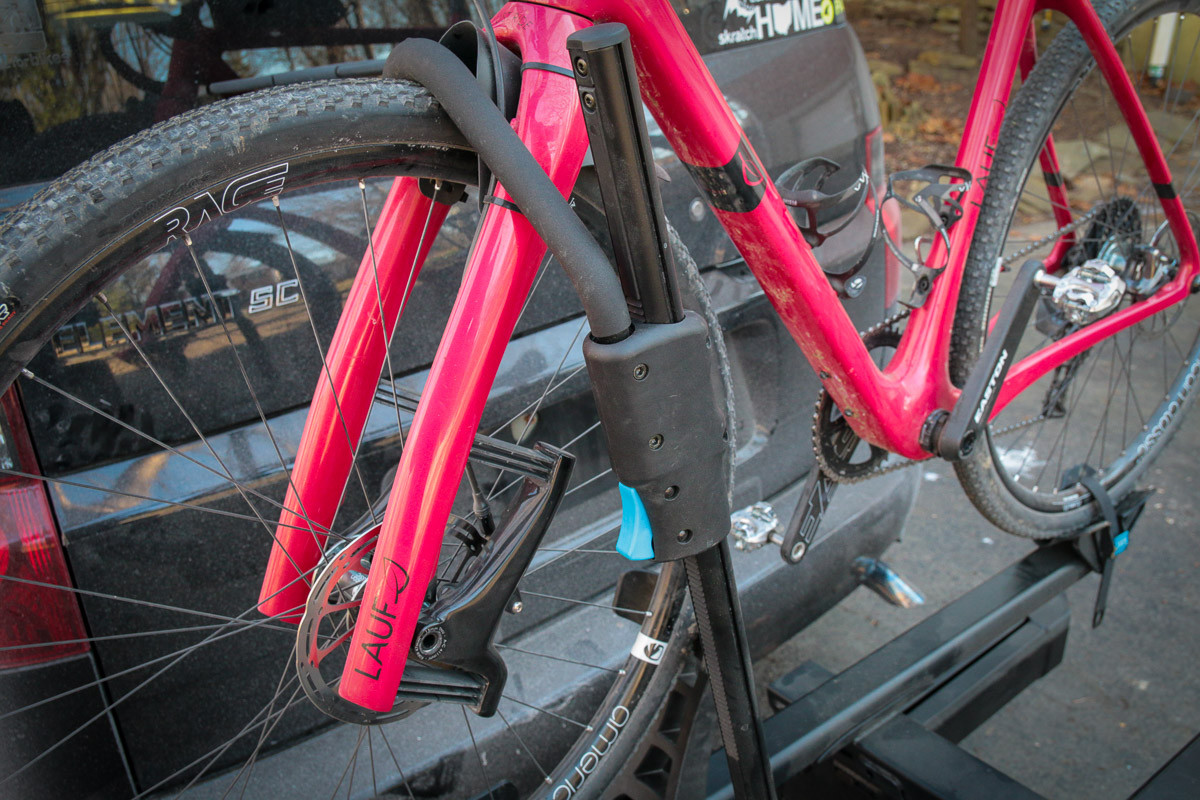 Rocky Mounts MonoRail
Rocky Mounts MonoRail
The Rocky Mounts MonoRail performs alongside the more expensive competition despite costing several hundred dollars less. (photo/Zach Overholt)
Best Premium Hitch Bike Rack
Kuat Piston Pro X
Check Price at REI
Check Price at Evo
 The Best Hitch Bike Racks of 2024
The Best Hitch Bike Racks of 2024
Key Specs:
- MSRP: $1,389
- Bike Capacity: 2 (expandable to 4 with add-ons)
- Receiver Compatibility: 1.25” and 2”
- Rack Weight: 63 lbs
- Per Bike Weight Limit: 2” receiver: 67 lbs, 1.25” receiver: 60 lbs
- Maximum Wheelbase: 53” (1,346mm)
- Maximum Tire Width: 5”
- Wheel Size Compatibility: 18” to 29” (fender kit available)
- Security Features: Hitch pin lock and 12mm steel cable lock included
Pros:
- Striking and refined aesthetic design
- Integrated LED brake lights and turn signals
- Effortless one-touch hydraulic clamp arms
- Comprehensive and robust security features
- Highly versatile bike compatibility
- Zero frame or rim contact
Cons:
- Premium price point represents a significant investment
The Kuat Piston Pro X unequivocally claims the title of best receiver hitch bike rack in the premium category. Kuat has spared no expense in its design and feature set, resulting in a rack that justifies its high price tag with unparalleled performance and unique functionalities. For cyclists who demand the very best and are willing to invest in top-of-the-line equipment, the Piston Pro X delivers an unmatched bike transport experience.
The Piston Pro X sets itself apart with its innovative tire-only bike securement system, eliminating any contact with the bike frame or even the wheels. This is particularly crucial for owners of high-end bikes who prioritize preserving pristine frame finishes. The opposing clamp arms are hydraulically actuated, offering effortless one-touch operation for loading and unloading bikes, a significant step up in user-friendliness compared to similar racks. Kuat’s signature tilt-release pedal, operable by foot or hand, further enhances convenience when folding the rack up or down.
Versatility is a cornerstone of the Piston Pro X’s design. The clamp arms are readily adjustable without tools, accommodating wheel sizes from 18 to 29 inches and tire widths from skinny road tires to 5-inch fat bike treads. An optional fender kit extends compatibility to bikes equipped with fenders. A generous 53-inch (1,346mm) maximum wheelbase capacity ensures compatibility with even the longest mountain bikes, while the robust 67 pounds per-bike weight limit (60 lbs for the 1.25″ receiver version, 42 lbs off-road) confidently handles heavier e-bikes. For added convenience with heavier bikes, Kuat offers an optional loading ramp, allowing you to roll bikes onto the rack instead of lifting. One or two bike add-ons are also available, albeit at a premium, for expanding capacity to 3 or 4 bikes.
Assembly of the Piston Pro X is designed for ease, and the rack comes equipped with comprehensive security features. A heavy-duty metal hitch pin lock and a substantial 12mm cable lock, long enough to secure two bikes through both frames and wheels, are included. An anti-wobble cam within the hitch, requiring a unique security Allen key stored conveniently at the rack’s end, adds another layer of security. Integrated LED lights function as bright brake lights and turn signals, enhancing visibility and safety. Kashima-coated pistons add a touch of visual flair, while the durable powder-coated finish and predominantly metal construction ensure long-term durability and justify the investment. Kuat also offers an optional license plate mount kit for users who wish to add one.
Like most tray-style hitch racks, the Piston Pro X is relatively heavy at 63 pounds and somewhat bulky for storage when not in use. However, the most significant barrier to entry is undoubtedly its high cost. For those willing and able to afford the Kuat Piston Pro X, it delivers an unmatched premium experience, making it the best receiver hitch bike rack for discerning cyclists. For those seeking a similar rack without the lights and Kashima-coated pistons, the Piston Pro offers essentially the same functionality at a $300 savings.
For a more in-depth analysis, refer to our full review of the Kuat Piston Pro X.
 Kuat Piston Pro X with lights off
Kuat Piston Pro X with lights off
Testing the Piston Pro X hitch bike rack. (photo/Zach Overholt)
Best Hitch Bike Rack For Durability
1Up USA 2″ Heavy Duty Double
 The Best Hitch Bike Racks of 2024
The Best Hitch Bike Racks of 2024
Key Specs:
- MSRP: $650 (silver) or $700 (black)
- Bike Capacity: 2 (expandable to 4 with add-ons)
- Receiver Compatibility: 2”
- Rack Weight: 46 lbs
- Per Bike Weight Limit: 50 lbs
- Maximum Wheelbase: 54” (1,371mm)
- Maximum Tire Width: 3.1” (up to 5” with spacer kit)
- Wheel Size Compatibility: 16” to 29”
- Security Features: Hitch lock included
Pros:
- Exceptionally durable all-metal construction
- Trays fold compactly when not in use for easier storage
- Moderate rack weight
- Versatile bike fit compatibility
- Zero frame or rim contact
- Rated for RV, travel trailer, and off-road use
Cons:
- Wheel size adjustments require tools
- Bike loading may be slightly less intuitive than some competitors
- Tilt release mechanism can be less accessible
The 1Up USA 2″ Heavy Duty Double Rack enjoys a devoted following among cyclists, renowned for its legendary durability and robust construction. This rack is built to last, often outliving the vehicles that carry them, making it a worthwhile long-term investment. Crafted entirely from steel and aluminum, with replaceable metal hardware, the Heavy Duty Double Rack eliminates plastic components prone to failure and resists rust and corrosion far better than most racks over extended use, solidifying its claim as the best receiver hitch bike rack for durability.
Beyond its exceptional longevity, the Heavy Duty Double Rack also offers impressive versatility. It accommodates bikes weighing up to 50 pounds each, fits wheel sizes from 16” to 29”, and handles tires up to 3.1” wide (expandable to 5” with an optional spacer kit). Add-on trays are available to increase carrying capacity to 3 or 4 bikes. The rack utilizes opposing ratcheting arms that securely grip the bike by the tires only, eliminating any risk of damage to frame paint or rim finishes. The trays are non-directional, allowing bikes to be placed facing either way, and lateral adjustability helps prevent bike-on-bike contact.
When not in use, the “tire hold” design and folding ratcheting arms create a remarkably compact package. When folded up, the rack sits close to the vehicle, minimizing protrusion. At a moderate 46 lbs, it’s manageable to carry, and the folding trays further enhance its storage convenience. The rack arrives fully assembled, requiring only unpacking and unfolding before use.
The Heavy Duty Double Rack’s robust build extends to its suitability for RVs, travel trailers, and off-road use. Slightly tiered trays provide increased ground clearance for uneven terrain. For heavier bikes, the 2” Super Duty Double variant offers the same design with a 75-pound bike weight capacity. For 1.25” receiver compatibility, the Equip-D Double provides similar functionality with a more accessible tilt-release handle. 1Up USA also offers accessories like a V Style Ramp ($122) for easier loading of heavy bikes, light kits, locks, and replacement parts for virtually every component of their racks.
Despite its numerous strengths, the 1Up USA 2” Heavy Duty Double has a few minor drawbacks. The ratcheting clamp arms are slightly less user-friendly than some competitors, requiring two hands to open from their stowed position. The tilt-release mechanism is also less accessible, making folding the rack up when not in use slightly more cumbersome (1Up USA offers the EZ Pull accessory to address this). The rack includes an anti-wobble cam requiring a security Allen key and a hitch bar lock, but a separate cable or chain lock is needed to secure the bikes themselves, which we generally recommend for any rack.
 1Up USA Heavy Duty Double
1Up USA Heavy Duty Double
The 1Up USA Heavy Duty Double is a durable rack that can handle abuse and probably outlast your vehicle. (photo/Fred Stamm)
Best Swing-Away Hitch Bike Rack
Rocky Mounts BackStage Swing Away
Check Price at Backcountry
Check Price at Amazon
 The Best Hitch Bike Racks of 2024
The Best Hitch Bike Racks of 2024
Key Specs:
- MSRP: $770
- Bike Capacity: 2
- Receiver Compatibility: 2”
- Rack Weight: 62.4 lbs
- Per Bike Weight Limit: 60 lbs
- Maximum Wheelbase: 50” (1,270mm)
- Maximum Tire Width: 5”
- Wheel Size Compatibility: 20” to 29”
- Security Features: Hitch pin lock and cable lock included
Pros:
- 180-degree pivot for full vehicle rear access
- Lighter and more affordable than separate rack and swing-away extension combinations
- User-friendly operation
- Versatile bike fit compatibility
Cons:
- 2” receiver size only
- Close vehicle proximity may require hitch extension for handlebar clearance on some vehicles
- Not compatible with add-ons for increased bike capacity
For those prioritizing unrestricted access to the rear of their vehicle, particularly camper van owners or those with cabover campers, the Rocky Mounts BackStage Swing-Away emerges as the best receiver hitch bike rack with a swing-away feature. Unlike most brands that offer swing-away functionality as an add-on attachment to an existing rack, Rocky Mounts has ingeniously integrated this feature directly into the BackStage’s design. This integrated approach results in a lighter overall weight and a significantly lower cost compared to purchasing a separate rack and swing-away extension. The BackStage combines the proven design of the popular and affordable Rocky Mounts MonoRail with a robust swing-away arm, keeping bikes closer to the vehicle and enhancing stability.
Bike loading mirrors the user-friendly MonoRail, featuring folding front wheel cradles, clamp arms accommodating tires from 5-inch fat bike treads to narrow road bike tires, and ladder straps for rear wheel securement. It handles wheel sizes from 20 to 29 inches and wheelbases up to 50 inches (1,270mm), accommodating nearly all bike types. A 60 lbs per-bike weight limit makes it suitable for transporting heavier e-bikes as well. The conveniently located tilt-release handle allows for easy folding and tilting. Included hitch pin and cable locks provide a basic level of security for both the rack and bikes.
The swing-away mechanism is easily operated by loosening a large blue handle and releasing a pin, allowing the rack to pivot a full 180 degrees, even with bikes loaded. Closing and securing the rack is equally straightforward, feeling solid and wobble-free in operation. Long-term durability is a hallmark of Rocky Mounts racks, and the BackStage is no exception. Our testers have used the Backstage extensively for the past 5 years, and despite some minor cosmetic rust, it continues to function perfectly.
Drawbacks of the Rocky Mounts BackStage are minimal. Its close proximity to the vehicle might necessitate a hitch extension for vehicles with vertical rear doors, such as Sprinter vans or cabover campers, to prevent handlebar interference. This is less of a concern for vehicles with sloping rear doors. At 59 pounds, the BackStage is still relatively heavy and bulky, making it somewhat cumbersome to move and store. Bike capacity is limited to two bikes, with no add-on options available.
Despite these minor considerations, the Backstage presents a compelling option, especially for those prioritizing easy rear vehicle access. Its integrated swing-away design, combined with the proven performance of the MonoRail platform, makes it a top contender for the best receiver hitch bike rack with this sought-after feature.
 Rocky Mounts BackStage Swing Away
Rocky Mounts BackStage Swing Away
The Rocky Mounts BackStage swings out for easy access to the rear of your vehicle. (photo/Jeremy Benson)
Best Hitch Bike Rack for Storability and e-Bikes
Thule Epos
Check Price at REI
Check Price at Amazon
 The Best Hitch Bike Racks of 2024
The Best Hitch Bike Racks of 2024
Key Specs:
- MSRP: 2-bikes w/ lights: $1,250, 2-bike w/o lights: $1,000
- Bike Capacity: 2 (3-bike version available)
- Receiver Compatibility: 1.25” and 2”
- Rack Weight: 38 lbs
- Per Bike Weight Limit: 75 lbs (140 lbs total)
- Maximum Wheelbase: 53” (1,350mm)
- Maximum Tire Width: 3” (up to 4.7” with XXL Fatbike Wheel Straps)
- Wheel Size Compatibility: 16” to 29”
- Security Features: Locking hitch knob, locking steel reinforced ladder straps on telescoping arms
Pros:
- Exceptional 75-pound per bike weight limit (up to 140 lbs total)
- Folds in half to a remarkably small footprint for storage
- Integrated wheels and handles for effortless maneuverability when not in use
- Compatible with virtually any bike type
- Optional lights and license plate kit, loading ramp, high-grade lock, and storage cover
- Available in 2 and 3-bike versions
Cons:
- Premium price point
- Bike attachment process can be slightly more involved
- Extensive use of plastic components
Thule’s latest offering, the Epos, is a significant step forward in hitch rack design, effectively blending high weight capacity, exceptional storability, and versatile bike compatibility. Building upon the foundation of the EasyFold XT, the Epos is engineered to transport virtually any bike, including heavy e-bikes, while remaining remarkably lightweight and compact when folded, making it the best receiver hitch bike rack for those prioritizing these features. The 2-bike version is available with ($1,250) and without lights ($1,000), and a 3-bike version without lights ($1,100) is also offered.
A standout feature of the Epos is its incredibly compact folded size and lightweight design. Weighing just 38 pounds (39.4 with lights, license plate holder, and ABUS lock installed) and folding in half, the Epos is remarkably easy to move and store. Integrated wheels and a carry handle enhance maneuverability, allowing it to be rolled like a suitcase and stored in minimal space. An optional rack cover is available for those seeking the most streamlined storage solution.
Installation and removal are quick and easy, utilizing Thule’s familiar stinger pin and locking anti-wobble knob system. The adjustable hitch receiver accommodates both 2 and 1.25-inch sizes, increasing versatility across different vehicles. Once mounted, the trays unfold readily to receive bikes. An optional loading ramp can be purchased to further ease loading of heavier e-bikes. The Epos also incorporates a tilt function for convenient rear vehicle access.
The Epos employs a unique telescoping arm design that allows for bike clamping on either the frame or the rear wheel, ensuring no frame contact. Swiveling heads on the telescoping arms, combined with long, steel-reinforced, locking, ratcheting ladder straps, facilitate secure and adaptable bike attachment. Additional ladder straps on the trays secure the front and rear wheels, providing three points of contact for maximum stability during transport. An optional High-Grade cable lock, developed in collaboration with ABUS, integrates seamlessly into the rack for enhanced bike security.
Versatility extends to bike compatibility, with a high 75 pounds per bike weight limit (140 lbs total) capable of handling even the heaviest e-bikes. The telescoping arms and long straps accommodate a wide range of frame styles and bike types, including bikes with fenders. It supports tires up to 3 inches wide (expandable to 4.7 inches with XXL Fat Bike straps), wheel sizes from 16 to 29 inches, and wheelbases up to 53 inches (1,350mm), accommodating almost any bike imaginable.
The primary criticism of the Thule Epos is that the bike loading and attachment process is slightly more complex than some simpler models, involving three ratcheting straps and a telescoping arm. The rack also incorporates a significant amount of plastic components, which may raise concerns about long-term durability under heavy use or careless handling. The price point is also relatively high, and optional accessories like lights, license plate holder, and the high-grade lock further increase the overall cost. However, for those prioritizing storability, versatile bike fit, and high weight capacity for e-bikes, the Thule Epos presents a compelling and feature-rich solution, justifying its premium price.
 The Thule Epos in its folded position attached to a vehicle
The Thule Epos in its folded position attached to a vehicle
Believe it or not, this 38 lb rack can carry virtually any bike up to 75 lbs (140 lbs total) and it takes up almost no storage space. (photo/Jeremy Benson)
Best Vertical Carry Hitch Bike Rack
1Up USA Recon Rack
 The Best Hitch Bike Racks of 2024
The Best Hitch Bike Racks of 2024
Key Specs:
- MSRP: Recon 5: $1,200, Recon 6: $1,400
- Rack Weight: 92 lbs
- Bike Capacity: 5 or 6 (depending on model)
- Receiver Compatibility: 2” only
- Per Bike Weight Limit: 45 lbs (225 lbs total for Recon 5, 270 lbs total for Recon 6)
- Bike Attachment Style: Vertical hang, front wheel cradle, rear wheel strap
- Maximum Wheelbase: n/a
- Maximum Tire Width: 3” (Fat Bike Baskets fit up to 5.1”)
- Wheel Size Compatibility: 20” to 29” (choose baskets at checkout)
- Security Features: Locking hitch pin included, welded lock loop, works with Recon cable lock (sold separately)
Pros:
- All-metal construction for ultimate durability
- More versatile and easier to load than fork-hang vertical racks
- Customizable wheel basket selection at checkout
- Tilts down for vehicle access
- No frame or fork contact
- Rated for off-road use
- Lifetime warranty
- Shipping included in purchase price
Cons:
- Premium price point
- Rear wheel strap system can be slightly more involved than other designs
- 45 lbs per bike weight limit may not accommodate heavier full-power e-bikes
- Rear wheel straps require careful management to avoid loss
The 1Up USA Recon Rack represents 1Up USA’s foray into the vertical carry hitch rack market, leveraging their renowned reputation for durability and robust construction. Following their acquisition of Recon Racks, 1Up USA has developed the Recon, a well-engineered vertical rack available in 5 and 6-bike versions. Made in the USA with all-metal construction and backed by a lifetime warranty, the Recon is built to withstand years of heavy use, making it the best receiver hitch bike rack in the vertical category for durability and longevity.
Loading bikes onto the Recon is straightforward and efficient. Simply lift the bike, place the front wheel into the basket, and secure the rear wheel with the webbing cam strap looped over the pedal. This strap system effectively holds the rear wheel against the lower crossbar while simultaneously applying downward tension to prevent bouncing on rough terrain and securing the pedals/cranks to prevent rotation and potential damage to neighboring bikes. The Recon carries bikes without any frame or fork contact.
The standard wheel baskets accommodate tires up to 3 inches wide and wheel sizes from 24 to 29 inches, suitable for mountain, gravel, and road bikes. Customers can customize their Recon at checkout by selecting Fat Bike baskets (for tires up to 5.1 inches wide) or Kids baskets (for 20 to 24-inch wheel sizes). These baskets can also be purchased separately for $149 each after initial purchase. The 45 lbs per bike weight limit easily handles non-electric bikes and lightweight eMTBs, although heavier full-power electric bikes may exceed this limit.
The Recon rack is constructed entirely from steel with a durable black powder coat finish, resulting in a burly and exceptionally well-made product. Heavy-duty locking hardware ensures structural integrity, and the massive pivot is over-engineered for stability, longevity, and smooth tilt operation. The rack includes an anti-wobble hitch bar insert and a locking hitch pin for secure attachment to the vehicle. With bikes removed, the entire rack tilts down to allow easy access to the vehicle’s rear. It is rated for off-road use, and the vertical support is height adjustable for customized ground clearance.
Like other vertical racks, the Recon is heavy (92 lbs) and bulky. Moving and storing it when not in use can be challenging without accessories like the 1Up Rack Stand ($309), which holds it upright and allows for wheeled transport. The Recon does not include bike locks, but 1Up USA offers a robust, 9-foot, Recon-specific cable lock ($52), and a welded lock loop allows for the use of aftermarket locks.
At $1,200 for the Recon 5, the rack is a significant investment. However, it remains more affordable than many tray racks when factoring in add-ons required to carry four bikes. Given 1Up USA’s legendary durability and lifetime warranty, the Recon 5 represents a long-term investment that delivers exceptional value and performance over time. Further details can be found in our full review of the 1Up Recon Rack.
 The 1Up Recon 5 loaded with 3 mountain bikes
The 1Up Recon 5 loaded with 3 mountain bikes
The 1Up Recon racks bring 1Up’s legendary durability to the vertical carry design. (photo/Jeremy Benson)
Best Value Vertical Carry Hitch Bike Rack
VelociRAX
 The Best Hitch Bike Racks of 2024
The Best Hitch Bike Racks of 2024
Key Specs:
- MSRP: $885 (5-bikes), 3, 4, 5, 6, 7-bike versions
- Bike Capacity: 5
- Receiver Compatibility: 2” only
- Rack Weight: 89 lbs (5-bike)
- Per Bike Weight Limit: 55 lbs
- Maximum Wheelbase: n/a
- Maximum Tire Width: 3” (up to 5” with Fat Bike Tire Baskets)
- Wheel Size Compatibility: 20” to 29”
- Security Features: Locking hitch pin included, compatible with “Integrated Locking System” (sold separately)
Pros:
- No frame contact bike mounting
- Easy bike loading and unloading process
- Hydraulic damper assist for controlled rack lowering, even when loaded
- Multiple versions available to suit various carrying needs
- Includes wall mount for rack storage and bike wall storage
Cons:
- Premium price point
- Large and heavy rack
VelociRAX stands out in the vertical hitch bike rack market by offering a wide range of models, accommodating from 3 to a remarkable 7 bikes. Their defining feature is the easy “roll-in” loading design, making bike loading and unloading exceptionally convenient. By tilting the rack down, the tire trays lower sufficiently to allow most full-size mountain bikes to be simply rolled into place. Lifting the rack back up and securing the wheels with straps completes the loading process quickly and effortlessly, positioning the VelociRAX as the best receiver hitch bike rack for value in the vertical category, balancing price with capacity and user-friendliness. Unloading is equally simple, with a “hinge assist damper” providing controlled lowering of the loaded rack, allowing bikes to be rolled out just as easily as they were loaded.
The wheel cradles support bikes by the front wheel, ensuring no frame or fork contact, making the VelociRAX compatible with road, gravel, and mountain bikes. Out of the box, it accommodates tires from 700c road tires up to 29″ x 3.0″ mountain bike tires. Wider fat bike tire cradles are available separately for tires up to 5.0″. Both front and rear wheels are secured with straps for stability during transport. Standard racks feature 10-inch spacing between bikes, while X versions (available in 3 and 5-bike sizes) offer wider 15-inch spacing, better suited for bikes with drop handlebars.
With a 55 lbs per bike weight limit (230 lbs max), the VelociRAX can handle most full-power e-MTBs. They come with a 2-year warranty, and replacement wear parts like wheel straps are readily available, along with accessories like lights and locks. VelociRAX racks are competitively priced within the vertical hanging rack category, and the included garage mount adds further value. This garage mount enables safe upright storage of the rack when not in use and doubles as a convenient wall-mounted bike storage solution.
 VelociRAX
VelociRAX
The VelociRax 5X loaded up with 3 bikes after a day of riding. (photo/Jake Dore)
Best Top Tube Hanging Hitch Bike Rack
Yakima FullSwing
Check Price at REI
Check Price at Amazon
 The Best Hitch Bike Racks of 2024
The Best Hitch Bike Racks of 2024
Key Specs:
- MSRP: $649
- Bike Capacity: 4
- Receiver Compatibility: 2″ only
- Rack Weight: 56 lbs
- Per Bike Weight Limit: 40 lbs (150 lbs max)
- Maximum Wheelbase: N/A
- Maximum Tire Width: N/A
- Wheel Size Compatibility: N/A
- Security Features: Locking SpeedKnob and integrated cable lock
Pros:
- Convenient swing-away feature for vehicle access
- Carries up to 4 bikes
- Padded bike cradles
- User-friendly Zip strips for bike securement
- Tool-free installation and removal
Cons:
- Bike frame contact mounting
- Bike-on-bike contact is difficult to avoid
- Inherently less stable design compared to other hitch rack styles
- 40 lbs per bike weight limit
Top tube hanging racks are generally not our preferred method for transporting bikes, but for certain users and specific needs, they can be a practical and cost-effective solution. For those seeking a top tube hanging rack with enhanced features, the Yakima FullSwing stands out as the best receiver hitch bike rack in this category, primarily due to its integrated swing-away functionality. While not ideal for precious carbon bikes or frequent use, the FullSwing caters to families, occasional users, and those less concerned with minor frame finish wear.
The FullSwing carries up to 4 bikes, suspending them by their top tubes on padded support arms. Curved ladder straps, known as Zip Strips, secure the bikes over the top tube, and each bike position includes an anti-sway attachment for the seat tube, enhancing stability. This attachment system is user-friendly and provides a reasonably secure hold. A key advantage of the FullSwing is its swing-away capability, allowing the entire rack to pivot away from the vehicle, even when loaded with bikes, for easy rear access. The support arms can be folded down when not in use, reducing its overall footprint compared to tray or vertical racks.
It features a 40 lbs per bike weight limit and a 150 lbs maximum capacity, suitable for standard non-electric bikes with traditional frame shapes but not heavier e-bikes. Bikes with curved top tubes or complex full suspension designs may require the Yakima TopTube adapter ($49) for proper fitment. Installation and removal are tool-free, and the locking SpeedKnob secures the rack to the vehicle, while a thin cable lock extends from the mast to provide basic bike security.
Due to its top tube hanging design, the FullSwing does present some inherent limitations. Frame paint damage is a potential concern due to frame contact. Bike-on-bike contact is difficult to avoid when carrying multiple bikes, and loading 4 bikes can be somewhat puzzling, although manageable with practice. Top tube hanging racks are inherently less stable than other styles, resulting in more bike sway and bounce during transit.
Despite these limitations inherent to top tube hanging racks, the Yakima FullSwing remains a viable option for families, occasional rack users, and those less concerned with frame finish perfection. The swing-away feature provides a significant convenience for vehicle access. For those who don’t require the swing-away feature, the Yakima FullTilt 5 ($499) offers a similar rack with a tilt function and 5-bike capacity at a lower price point.
 Yakima FullSwing
Yakima FullSwing
Testing the Yakima FullSwing with multiple fat bikes. (photo/Zach Overholt)
Best of the Rest
Another Great Value
Kuat Transfer V2 2-bike
Check Price at REI
Check Price at Amazon
 The Best Hitch Bike Racks of 2024
The Best Hitch Bike Racks of 2024
Key Specs:
- MSRP: 2-bike: $489
- Bike Capacity: 2 (up to 4 with add-ons)
- Receiver Compatibility: 1.25” and 2”
- Rack Weight: 37 lbs (2” version)
- Per Bike Weight Limit: 2” receiver: 60 lbs, 1.25” receiver: 40 lbs
- Maximum Wheelbase: 50” (1,270mm)
- Maximum Tire Width: Up to 5” with Phat Bike Kit ($15)
- Wheel Size Compatibility: 18” to 29”
- Security Features: Tamper-resistant hitch cam and semi-integrated cable lock included
Pros:
- Lightweight design
- Affordable price point
- Versatile bike fit compatibility
- 60 lbs per bike weight limit
- Included security features
Cons:
- Tilt-release lever can be awkward to operate with bikes loaded
- Less refined finish compared to higher-end competitors
- More involved assembly process
- No lateral bike adjustability
The Kuat Transfer V2 2-Bike provides an even more budget-friendly entry point into Kuat’s renowned hitch rack quality. At roughly half the price, or less, of our top-rated models, the Transfer V2 offers a compelling blend of affordability and performance. Utilizing a simplified design and construction, it delivers reliable bike transport without sacrificing essential features or bike security, making it a strong contender for the best receiver hitch bike rack for value-conscious buyers. While it may lack the refined aesthetics and premium features of more expensive Kuat models, it performs admirably and securely carries a wide range of bikes without frame contact.
The Transfer V2 secures bikes via a front wheel clamp that contacts only the tire, accommodating wheel sizes from 18 to 29 inches and tires up to 5 inches wide (with an optional Phat Bike Kit). The rear wheel is secured with a simple ladder strap. It handles wheelbases up to 50 inches (1,270mm), fitting most bikes except extremely long mountain bikes.
Weighing in at a mere 37 pounds, the Transfer V2 is lighter than most tray-style racks, simplifying installation, removal, and storage. Despite its lighter weight, it boasts an impressive 60 lbs per bike weight limit (for the 2” receiver version). The 2-inch receiver size is also RV chassis mountable, although the weight rating reduces to 40 pounds per bike in this configuration (2-bike version only, no add-ons). Security features include a cable lock to secure bikes to the rack and an anti-wobble cam requiring a security Allen key. While not impenetrable, these features offer a significant deterrent against theft of both the rack and bikes.
Criticisms of the Kuat Transfer V2 are minimal considering its price point. Its lighter build and some plastic components may raise concerns about long-term durability compared to more robust racks, although we have observed them lasting for several years of regular use. The tilt release foot lever’s position can be somewhat awkward to access, particularly with bikes loaded. Lateral bike adjustability is absent, potentially leading to bike-on-bike interference, especially with drop-bar bikes. Assembly is more involved than some other models, but it is a one-time process (unless purchasing pre-assembled).
We tested the Transfer V2 2-bike, but it is also available in one-bike ($389) and three-bike ($589) versions. Adding the Transfer 1-bike extension ($189) to any of these models allows for expansion up to four bikes (2” hitch version required for extension), offering a cost-effective way to transport more bikes compared to many 2-bike models with add-ons.
High Weight Capacity
Yakima StageTwo
Check Price at Evo
Check Price at Amazon
 The Best Hitch Bike Racks of 2024
The Best Hitch Bike Racks of 2024
Key Specs:
- MSRP: $799
- Bike Capacity: 2 (up to 4 with add-on)
- Receiver Compatibility: 1.25” and 2”
- Rack Weight: 66 lbs
- Per Bike Weight Limit: 70 lbs
- Maximum Wheelbase: 52” (1,320mm)
- Maximum Tire Width: 3.25” (up to 5” with Fat Bike Kit)
- Wheel Size Compatibility: 20” to 29”
- Security Features: Locking SpeedKnob, integrated cable locks, welded lock loop on rack
Pros:
- Robust and overbuilt construction
- High 70-pound per bike weight limit
- Versatile bike fit compatibility
- Optional loading ramp for heavy bikes
- User-friendly features like remote tilt-release handle and SpeedKnob
- Available in two color options
Cons:
- Relatively high price point
- Large and bulky size
- Heavy rack weight
- Tilt release handle can occasionally stick
The Yakima StageTwo represents Yakima’s latest generation of hitch racks and is arguably their most impressive model to date. This burly and robust rack excels in ease of use, versatility, and particularly in its exceptional 70 lbs per-bike weight capacity, making it the best receiver hitch bike rack for users prioritizing high weight capacity and robust construction. The StageTwo confidently handles virtually any bike, including heavier e-bikes, and an optional RampUp loading ramp ($99) further simplifies loading heavier bikes. It is also RV-rated up to 60 lbs per bike and off-road rated to 42 lbs per tray.
While the StageTwo is relatively heavy at 66 pounds, installation and removal are streamlined thanks to Yakima’s tool-free SpeedKnob system. This system securely tightens the receiver arm within the hitch, eliminating wobble and locking the rack to the vehicle. The tilt release handle, conveniently located at the end of the main support arm, enables effortless folding and tilting, even when loaded with bikes, providing easy access to the vehicle’s rear.
Large StrongArm hooks securely clamp down over the front wheel, accommodating wheel sizes from 20 to 29 inches and tires up to 3.25 inches wide. The Fat Bike Kit allows for carrying bikes with tires up to 5 inches wide. The trays are designed for wheelbases up to 52 inches (1,320mm), with sliding rear tire cradles and ladder straps. For enhanced visibility, Yakima offers the optional SafetyMate ($219), a light and license plate kit that integrates seamlessly with the StageTwo.
Security features include the locking SpeedKnob and integrated cable locks extending from the clamp arms to loop through bike frames or forks. Yakima has also incorporated a welded steel loop on the main support arm for attaching an additional lock for enhanced security. The trays are slightly tiered for ground and bike clearance, and lateral tray adjustment is possible, though requiring tools and some effort. For increased bike capacity, the StageTwo 2-bike add-on ($599) expands carrying capacity to 4 bikes (2-inch receiver version only).
The StageTwo’s robust construction and high weight capacity contribute to its large and bulky size. It is both heavy and wide, requiring considerable storage space. The price point is also relatively high, and accessories like the RampUp loading ramp and Fat Bike Kit add to the overall cost. Despite these considerations, for those prioritizing high weight capacity, durability, and ease of use, particularly for transporting e-bikes, the StageTwo is the best receiver hitch bike rack Yakima offers in this category.
Rocky Mounts GuideRail
Check Price at Competitive Cyclist
Check Price at Amazon
 The Best Hitch Bike Racks of 2024
The Best Hitch Bike Racks of 2024
Key Specs:
- MSRP: $849.95
- Bike Capacity: 2 (Up to 3 with add-on, 2” receiver size only)
- Receiver Compatibility: 1.25” and 2”
- Rack Weight: 49 lbs
- Per Bike Weight Limit: 60 lbs
- Maximum Wheelbase: 36” up to 55” (1,397mm)
- Maximum Tire Width: 3”
- Wheel Size Compatibility: 20” to 29”
- Security Features: Locking hitch pin and 10mm square link chain included
Pros:
- Tire-only bike mounting, eliminating frame and wheel contact
- Excellent security features
- Easier bike loading compared to some similar racks
- Easily accessible tilt-release handle
- Predominantly metal construction
Cons:
- Close vehicle proximity may require hitch extension for some vehicles
- Relatively high price point
The GuideRail marks a departure for Rocky Mounts, moving beyond their traditional tray rack designs. This newer model, similar in concept to the 1Up USA and Kuat Piston Pro X, secures bikes via opposing wheel clamps, ensuring tire-only contact and eliminating any risk of frame or rim damage. The GuideRail boasts a sleek black finish with anodized blue accents and a predominantly metal construction, projecting a premium and durable feel, making it a strong contender for best receiver hitch bike rack in the tire-contact category. It handles bikes up to 60 lbs each, and a reasonably priced GuideRail 1-bike add-on ($280) expands capacity to 3 bikes (2” receiver only), although the per-bike weight limit reduces to 45 lbs each with the add-on.
The GuideRail’s well-engineered design prioritizes ease of use with several thoughtful features. A conveniently located remote tilt release handle facilitates effortless rack folding, tilting, and vehicle access. The wheel clamps are exceptionally user-friendly, featuring large release levers allowing for one-handed arm adjustment and streamlined bike loading. Clamp arms accommodate tire widths from 19mm road tires up to 3” and wheel diameters from 20” to 29”. Tiered trays provide ample space for bikes with wheelbases up to 55” (1,397mm), accommodating virtually any bike, and offer sufficient lateral adjustability to minimize bike-on-bike contact.
Beyond user-friendliness, the GuideRail prioritizes security with robust features to protect both the rack and bikes. It includes a locking hitch pin and a substantial 10mm square link chain that can be looped through bike frames and secured to the rack’s main support arm. This chain lock is significantly more robust than typical included locks, providing a genuine security enhancement.
Minor drawbacks of the GuideRail include the tool-required wheel clamp adjustment for different wheel sizes (tools are included). Its close vehicle proximity may also necessitate a hitch extension for some vehicles, particularly camper vans, to prevent handlebar contact. While competitively priced among similar racks, the GuideRail remains a relatively expensive investment. Despite these minor points, the Rocky Mounts GuideRail is an excellent option for cyclists seeking a secure, tire-contact rack with user-friendly features. For those interested in this rack with a swing-away feature, the Rocky Mounts AfterParty is worth considering.
For a more comprehensive evaluation, refer to our full review of the Rocky Mounts GuideRail.
Kuat NV 2.0
Check Price at REI
Check Price at Amazon
 The Best Hitch Bike Racks of 2024
The Best Hitch Bike Racks of 2024
Key Specs:
- MSRP: $898 ($798 for the NV Base 2.0)
- Bike Capacity: 2 (up to 4 with add-ons, 2” receiver size only)
- Receiver Compatibility: 1.25” and 2”
- Rack Weight: 56 lbs
- Per Bike Weight Limit: 60 lbs
- Maximum Wheelbase: 50” (1,270mm)
- Maximum Tire Width: Up to 5” with Phat Bike Kit
- Wheel Size Compatibility: 20” to 29”
- Security Features: Locking hitch pin and integrated cable locks included
Pros:
- Integrated Trail Doc repair stand
- Sleek aesthetics and durable powder coat finish
- Loading ramp accessory available
- 60 lbs per bike weight limit
- Available in two color options
Cons:
- No lateral tray adjustment (front wheel cradles adjust)
- Relatively high price point
- Tilt release lever can be less accessible with bikes loaded
The Kuat NV 2.0 established a high benchmark for both style and performance when it debuted several years ago. Its striking design and glossy metallic powder coat finish made it stand out from the competition, turning heads with its premium aesthetics. It has remained a cornerstone of Kuat’s lineup, recently surpassed in top-tier positioning by the Piston Pro X and Piston Pro but still representing a very strong contender for best receiver hitch bike rack in its category.
Like most high-quality tray racks, the NV 2.0 is highly versatile, accommodating virtually any bike up to 60 lbs each. The NV 2.0 carries 2 bikes, and 1-bike and 2-bike add-ons are available to expand capacity to 3 or 4 bikes (2” receiver size only), although this reduces the per-bike weight limit when fully expanded. The front wheel cradles and hook-shaped front wheel clamps accommodate tires up to 5 inches wide and wheel sizes from 20 to 29 inches. The rear wheel strap slides along the tray to fit wheelbases up to 50 inches (1,270mm) and most tire types (fat tires require the Phat Bike Kit). For heavier e-bikes, an optional Access Bike Ramp ($98) is available to assist in rolling bikes onto the trays.
The rack is relatively heavy at 56 lbs, but installation and removal are user-friendly with a tension knob for the anti-wobble hitch cam. A locking hitch pin secures the rack itself, and integrated cable locks extend from the trays to deter bike theft. The tilt release lever, operable by hand or foot, facilitates easy folding and tilting of the unloaded rack. The NV 2.0 (not the Base version) includes the Trail Doc, a mini repair stand that extends from the rack, providing convenient maintenance and repair capabilities on road trips or at trailheads without requiring a separate work stand.
Like comparable racks, the NV 2.0 is somewhat heavy and bulky, making storage less convenient. The trays are fixed in position without lateral adjustability, although the front wheel cradles offer slight adjustment to compensate. Bike-on-bike interference may still occur with certain bike combinations, particularly with drop-bar bikes. The NV 2.0’s price is in line with other high-end racks, but it is not inexpensive. The NV Base 2.0 offers essentially the same rack with a matte finish and without the Trail Doc for a hundred-dollar savings.
For a more detailed analysis, see our full review of the Kuat NV 2.0.
Yakima OnRamp
Check Price at REI
Check Price at Amazon
 The Best Hitch Bike Racks of 2024
The Best Hitch Bike Racks of 2024
Key Specs:
- MSRP: $699
- Bike Capacity: 2
- Receiver Compatibility: 1.25” and 2”
- Rack Weight: 43 lbs
- Per Bike Weight Limit: 66 lbs
- Maximum Wheelbase: 50” (1,270mm)
- Maximum Tire Width: 29” x 3.25” (up to 27.5” x 4.5” with FatStrap Kit)
- Wheel Size Compatibility: 20” to 29”
- Security Features: Cable lock – locks bikes and hitch pin
Pros:
- Capable of carrying heavy e-bikes
- Loading ramp included
- Moderate 43 lbs rack weight
- Designed for compatibility with a wide range of bike frame styles
- More affordable than other e-bike specific racks
Cons:
- Bike loading process can be somewhat clunky
- Tilt release mechanism is difficult to reach and may require two people with bikes loaded
- Frame contact bike mounting
Electric bikes are increasingly popular, and the Yakima OnRamp is Yakima’s dedicated solution for simplifying e-bike transport, making it a strong contender for best receiver hitch bike rack designed specifically for e-bikes. This hitch rack is designed and marketed specifically for electric bikes, capable of carrying two bikes with a 66 lbs per bike weight limit (40 lbs RV and off-road), and includes a loading ramp for easier e-bike loading. Its attachment system is designed to accommodate most frame designs and bikes with fenders.
Recognizing the challenge of lifting heavier e-bikes, the OnRamp incorporates a loading ramp that conveniently stores directly on the rack, eliminating the need to store it separately. This ramp attaches to slots at either end of the trays, enabling easy roll-on and roll-off bike loading. A center mast between the trays features two swiveling clamps that secure bikes by the top tube or seat tube. These clamps are height and angle adjustable, designed to accommodate most, but potentially not all, frame shapes. Long ratcheting ladder straps secure the front and rear wheels to the trays.
Beyond its high weight capacity and roll-on loading, the OnRamp is also relatively lightweight at 43 lbs. Its frame-contact bike mounting system accommodates bikes with fenders and a range of wheel and tire sizes up to 3.25 inches. An optional FatStrap Kit ($20) expands tire compatibility to 27.5 x 4.5 inches.
While the OnRamp offers a solid e-bike transport solution, it does have some drawbacks. The bike loading process can feel somewhat clunky and less refined compared to many other models. Maintaining bike stability while securing them can be challenging initially, and assistance from a second person is recommended. The tilt release mechanism is also difficult to reach and requires two people to tilt the rack safely with bikes loaded. As it secures bikes by the frame, frame contact is unavoidable, and the frame clamps may not fit optimally on thin-tubed frames or around very bulbous frames.
Despite these considerations, once familiar with its operation, the Yakima OnRamp provides a robust solution for transporting heavy bikes at a more affordable price point compared to other e-bike specific racks.
North Shore Racks
Check Price at North Shore Racks
 The Best Hitch Bike Racks of 2024
The Best Hitch Bike Racks of 2024
Key Specs:
- MSRP: 6-bike: $900, 4-bike: $750, 2-bike: $600
- Bike Capacity: 2, 4, and 6 bike versions available
- Receiver Compatibility: 2” (2-bike version comes in 1.25” and 2”)
- Rack Weight: 6-bike: 72 lbs
- Per Bike Weight Limit: 60 lbs
- Maximum Wheelbase: n/a
- Maximum Tire Width: n/a
- Wheel Size Compatibility: n/a
- Security Features: None (hitch pin compatible with 1/4″ padlocks)
Pros:
- Higher weight capacity compared to similar vertical racks
- Carries up to 6 bikes simultaneously
- Adjustable height, angle, and setback
- Folds in half for storage
- Durable all-metal construction
Cons:
- Compatible only with bikes featuring suspension forks
- Fork cradles may cause paint damage over time
- Heavy rack weight
North Shore Racks are pioneers in the vertical hanging hitch rack category, trusted by mountain bikers for years. Their robust racks are a common sight for shuttle vehicles and offer a proven track record for reliability. Available in 2, 4, and 6-bike versions, the North Shore Rack is unique in offering a folding design for space-saving storage when not in use, making it a noteworthy best receiver hitch bike rack in the vertical category for shuttle applications. It is also adjustable for height, angle, and setback, allowing for fine-tuning to optimize fit with different vehicles and bike types.
The North Shore Rack utilizes fork cradles instead of wheel trays, designed specifically for mountain bikes with suspension forks. The fork crown slots into padded cradles, and the rear wheel is secured to a horizontal bar with a short rope. More recently, a road bike adapter ($75 each) has been developed, enabling compatibility with road and gravel bikes (with front wheel removal).
The North Shore Rack boasts a high 60 lbs per bike weight limit, exceeding similar vertical hanging models and making it capable of carrying heavier full-power electric mountain bikes. Once the loading process is mastered – always loading from left to right – bike loading is quick and efficient, ideal for shuttle runs. Replacement parts for wear items are readily available, ensuring long-term rack maintenance.
Despite its strengths, the North Shore Rack has some limitations. The fork cradles are known to potentially cause paint abrasion on fork crowns over time. Front wheels require separate securement with bungee cords or ropes to prevent spinning during transit. Security features are absent, requiring users to provide their own hitch pin lock and cable locks to secure both the rack and bikes.
Kuat Sherpa 2.0
Check Price at REI
Check Price at Amazon
 The Best Hitch Bike Racks of 2024
The Best Hitch Bike Racks of 2024
Key Specs:
- MSRP: $689
- Bike Capacity: 2
- Receiver Compatibility: 1.25” and 2”
- Rack Weight: 32 lbs
- Per Bike Weight Limit: 40 lbs
- Maximum Wheelbase: 47” (1,194mm)
- Maximum Tire Width: 3”
- Wheel Size Compatibility: 20” to 29” (20” to 24” require adapter)
- Security Features: Hitch pin lock and cable lock included
Pros:
- Lightweight design
- Sleek and aesthetically pleasing design
- Available in 3 color options
- Comparatively smaller overall size
Cons:
- Lower per bike weight limit
- Limited wheelbase length compatibility
- No lateral tray adjustability
Kuat has established a reputation for producing hitch racks that are not only functional but also visually appealing, often complementing luxury vehicles. The Sherpa 2.0 embodies this philosophy, featuring a beautiful and durable powder coat finish available in three color options to match your vehicle. Its compact design, with stealthy fold-out front tire trays and a smaller overall size, makes it less obtrusive than other tray-style racks, potentially making it the best receiver hitch bike rack for users prioritizing lightweight design and aesthetics.
At a mere 32 pounds, the Sherpa 2.0 is among the lightest tray racks available, simplifying installation and removal compared to heavier models. It supports two bikes up to 40 pounds each, accommodating wheel sizes from 20 to 29 inches (20-24 inch wheels require an included adapter) and tires up to 3 inches wide. Bike loading is quick and easy with intuitive front wheel clamps and a rear wheel ladder strap. Included security features, such as a locking hitch pin and a long cable lock, help deter theft of both the rack and bikes.
The Sherpa 2.0 does have some limitations. Its 40 lbs per bike weight limit is insufficient for heavier e-bikes. Kuat specifies a maximum wheelbase of 47 inches (1,194mm), potentially limiting compatibility with longer modern mountain bikes. The trays lack lateral adjustability, increasing the risk of bike-on-bike interference, particularly with drop-bar bikes. The tilt release lever’s position requires reaching under the bikes to tilt the rack when loaded.
Despite these limitations, the Sherpa 2.0 remains an attractive option for those who frequently install and remove their rack due to its impressively low weight. For users primarily transporting lighter and smaller bikes, and needing to carry only two at a time, the Kuat Sherpa 2.0 is a user-friendly and reliable rack that combines functionality with stylish aesthetics.
Yakima HangOver
Check Price at Evo
Check Price at Amazon
 The Best Hitch Bike Racks of 2024
The Best Hitch Bike Racks of 2024
Key Specs:
- MSRP: 6-bike: $999, 4-bike: $799,
- Bike Capacity: 4 and 6 bike versions available
- Receiver Compatibility: 2” only
- Rack Weight: 6-bike: 73 lbs, 4-bike: 65 lbs
- Per Bike Weight Limit: 37.5 lbs
- Maximum Wheelbase: n/a
- Maximum Tire Width: n/a
- Wheel Size Compatibility: n/a
- Security Features: Locking hitch pin and welded lock loop
Pros:
- Carries up to 4 or 6 bikes
- Tilt function for rear vehicle access
- Widely available through retailers
- Adjustable mast height and tilt angle
Cons:
- 37.5 lbs per bike weight limit
- Compatible only with mountain bikes featuring suspension forks
- Heavy and bulky – difficult to store
Yakima entered the vertical carry hitch rack market with the HangOver, becoming one of the first major manufacturers to offer this style of rack. Available in 4-bike and 6-bike versions, the HangOver, like the North Shore Rack, is designed for mountain bikes with suspension forks, making it a noteworthy best receiver hitch bike rack option from a widely recognized brand in the vertical category. It secures bikes by the suspension fork crown, using rubber straps, and ratcheting straps for the rear wheels to maintain tightness.
The HangOver incorporates a foot-pedal-operated tilt function for rear vehicle access and offers two mast angles to prevent tire-vehicle contact during transit. The mast height is also adjustable for ground clearance. Security features include a locking hitch pin and a welded metal loop for users to add their own cable lock for bike security.
A key advantage of the Yakima HangOver is its widespread availability, carried by numerous bike shops and major online retailers, making it easier to find compared to some niche vertical rack brands. However, it does have drawbacks. The fork crown mounting system can potentially damage fork paint over time. It is not compatible with road or gravel bikes, or eMTBs, due to a lower 37.5 lbs maximum bike weight limit.
Hitch Bike Racks Comparison Chart
| Hitch Bike Rack | MSRP | Number of Bikes | Rack Weight | Per Bike Weight Capacity | Hitch Size Options | Security Features |
|---|---|---|---|---|---|---|
| Thule T2 Pro XTR | $750 | 2 (up to 4 with add-ons) | 52 lbs | 60 lbs | 1.25″ and 2″ | Locking hitch knob and integrated cable locks |
| Rocky Mounts MonoRail | $500 | 2 (up to 3 with add-ons) | 45 lbs | 60 lbs | 1.25″ and 2″ | Hitch pin lock and cable lock |
| Kuat Piston Pro X | $1,389 | 2 (up to 4 with add-ons) | 63 lbs | 67 lbs | 1.25″ and 2″ | Hitch pin lock and 12mm steel cable lock |
| 1Up USA 2″ Heavy Duty Double | $650 | 2 (up to 4 with add-ons) | 46 lbs | 50 lbs | 2″ | Hitch pin lock |
| Rocky Mounts BackStage | $770 | 2 | 62.4 lbs | 60 lbs | 2″ | Hitch pin lock and cable lock |
| Thule Epos | $1,000-$1,250 | 2 | 38 lbs | 75 lbs (140 lbs max) | 1.25″ and 2″ | Locking hitch knob and locking straps |
| 1Up Recon 5 | $1,200 | 5 (also comes in 6-bike) | 92 lbs | 45 lbs | 2″ | Hitch pin lock and welded steel lock loop |
| VelociRAX | $885 (5-bike) | 5 (also 3, 4, 6, and 7 bikes) | 89 lbs | 55 lbs (230 lbs max) | 2″ | Hitch pin lock |
| Yakima FullSwing | $649 | 4 | 56 lbs | 40 lbs (150 lbs max) | 2″ | Locking SpeedKnob and integrated cable lock |
| Kuat Transfer V2 | $489 | 2 (up to 4 with add-ons) | 37 lbs | 60 lbs | 1.25″ and 2″ | Tamper-resistant hitch tightener and cable lock |
| Yakima StageTwo | $799 | 2 (up to 4 with add-ons) | 66 lbs | 70 lbs | 1.25″ and 2″ | Locking SpeedKnob and integrated cable locks |
| Rocky Mounts GuideRail | $850 | 2 (up to 3 with add-ons) | 49 lbs | 60 lbs | 1.25″ and 2″ | Hitch pin lock and 10mm square link chain |
| Kuat NV 2.0 | $898 | 2 (up to 4 with add-ons) | 56 lbs | 60 lbs | 1.25″ and 2″ | Hitch pin lock and integrated cable locks |
| Yakima OnRamp | $699 | 2 | 43 lbs | 66 lbs | 1.25″ and 2″ | Cable lock |
| North Shore Racks | $900 (6-bike) | 6 (also 2 and 4 bikes) | 72 lbs | 60 lbs (300 lbs max – 6-bike) | 2″ | None |
| Kuat Sherpa 2.0 | $689 | 2 | 32 lbs | 40 lbs | 1.25″ and 2″ | Hitch pin lock and cable lock |
| Yakima HangOver | $999 (6-bike) | 6 (also 4-bike version) | 73 lbs | 37.5 lbs | 2″ | Hitch pin lock |
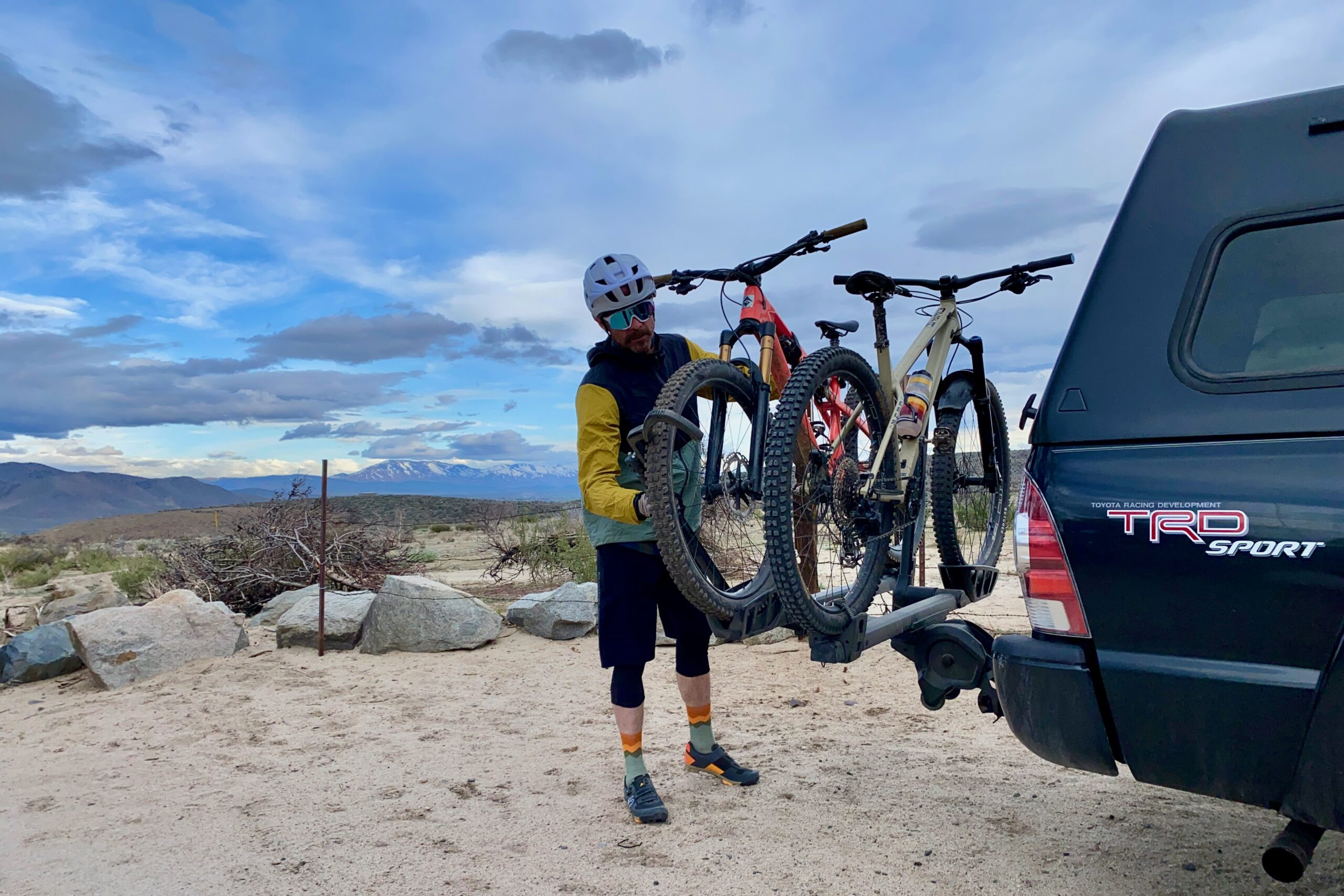 Testing the Thule T2 Pro XTR hitch bike rack
Testing the Thule T2 Pro XTR hitch bike rack
Testing hitch bike racks in the Nevada desert. (photo/Jeremy Benson)
Why Should You Trust Usabikers.net?
The team at usabikers.net is deeply passionate about all aspects of cycling. Cycling is not just our profession; it’s an integral part of our lives, encompassing work, recreation, fitness, training, racing, and commuting. We are dedicated cyclists who, like you, rely on our vehicles to transport ourselves and our valuable bicycles. Hitch-mounted bike racks are our preferred method for doing so, and we understand the nuances and importance of selecting the right rack.
For over a decade, we have been committed to rigorously testing and evaluating the latest bikes, technologies, components, and accessories, including a wide range of bike racks. During this time, we have hands-on experience with virtually every bike rack available on the market, whether for in-depth testing and review or for our personal use. We are constantly seeking the best, safest, and most secure ways to transport our bikes to trailheads, weekend getaways, and race events. In line with our commitment to bike security, we have also comprehensively tested and reviewed the best bike locks. Furthermore, we prioritize personal safety, which is why we have also rigorously tested and reviewed the best mountain bike helmets and the best road bike helmets.
Our experienced editors have dedicated years to testing cycling gear, developing a discerning eye for what constitutes a truly exceptional product. Each rack featured in this guide has been thoroughly used and evaluated by one or more members of our team to discern the often subtle performance differences that distinguish the good from the very best. In fact, many of the models highlighted here are our personal racks, having endured years of heavy use and real-world abuse. Rest assured, we are deeply connected to the cycling world, and as new models emerge, we will continue to test and evaluate them, ensuring this review remains as current and informative as possible. Our unwavering commitment is to assist you in finding the perfect rack to match your specific needs and budget.
 Yakima StageTwo
Yakima StageTwo
Loading up the bikes after a ride onto the Yakima StageTwo with SafetyMate light add-on. (photo/Jeremy Benson)
Buying Advice: How to Choose a Hitch Bike Rack
While numerous bike rack styles are available, we firmly believe that hitch-mount racks offer the optimal solution for transporting your bikes. However, hitch racks themselves come in various styles, necessitating careful consideration to determine the best option for your bikes and vehicle. Here, we break down the primary distinctions between tray racks, vertical carry racks, and top tube hanging racks, along with other crucial factors to consider when purchasing a hitch rack, ensuring you choose the best receiver hitch bike rack for your needs.
Types of Hitch Mount Bike Racks
Each type of hitch rack presents its own set of advantages and disadvantages. We will outline the key differences and delve into the pros and cons associated with each style to guide your decision.
 Carrying 2 bikes off road on a 1Up USA hitch bike rack
Carrying 2 bikes off road on a 1Up USA hitch bike rack
Tray racks support the bike on trays, or platforms, and typically come in 2-bike versions with many providing the option to expand capacity with add-ons. (photo/Steve Graepel)
Tray or Platform Hitch Bike Racks
Tray or platform hitch bike racks are often our preferred choice due to their user-friendliness and secure bike attachment methods. Bikes are positioned with their tires resting on trays or platforms, and arms typically clamp down on the front wheel while the rear wheel is secured with straps. Some models employ dual arms to secure both front and rear wheels. Tray racks are known for their stability and security. Certain models offer left-right adjustability to prevent handlebar-to-seat interference between bikes. Serious cyclists frequently favor tray racks because most designs secure bikes without frame contact, preserving the pristine condition of their bikes.
PROS: High-quality tray racks typically secure bikes without frame contact, eliminating scratches or paint rubbing. They generally offer more spacing between bikes, simplifying loading of larger bikes and wider tires. They are versatile, accommodating a wide range of wheel sizes, tire widths, and bike types. Some offer high weight limits, suitable for transporting heavier e-bikes. Lower loading heights minimize lifting effort when loading bikes onto the rack.
CONS: Most tray racks typically accommodate only 2 bikes (some extend to 4 with add-ons). They tend to be more expensive, and add-on extensions further increase the overall cost. Tray racks are often large and heavy, making storage more challenging if not left permanently on the vehicle.
 Loading up the North Shore Racks with several mountain bikes for more shuttle laps
Loading up the North Shore Racks with several mountain bikes for more shuttle laps
Vertical carry racks support bikes vertically, holding them by the front wheel, fork crown, or handlebar. (photo/Jeremy Benson)
Vertical Carry Hitch Bike Racks
Vertical carry hitch bike racks, once a niche category, are gaining popularity as more brands introduce models that hang bikes vertically. Traditionally used primarily for mountain bike shuttling, earlier models secured bikes by the suspension fork crown. More recent designs have increased versatility, with angled wheel baskets/trays that cradle the front wheel or systems that support bikes by the handlebar. Vertical carry racks can be among the easiest to load, although a specific loading order is typically required. Most models are offered in various configurations, accommodating 4 to 6 bikes.
PROS: High bike capacity, capable of carrying numerous bikes. Relatively quick and easy bike loading process. Typically no frame contact bike mounting.
CONS: Bulky and heavy, making them challenging to move and store when not in use. Bikes must be loaded and unloaded in a specific sequence. Some designs are limited to mountain bikes with suspension forks. Most models are only available in a 2” receiver size.
 4 bikes loaded on the Yakima FullSwing hitch bike rack
4 bikes loaded on the Yakima FullSwing hitch bike rack
Top Tube Hang racks support bikes by the top tube of the frame on two support arms. Frame contact is guaranteed, and bike-on-bike contact is very hard to avoid. (photo/Zach Overholt)
Top Tube Hanging Hitch Bike Racks
Top tube hanging hitch bike racks secure bikes by suspending the top tube across two arms extending from a central support beam. Bikes are simply slid over these arms, rested upon them, and then strapped in place. Improved models feature cradles and rubber or ratcheting ladder straps, along with systems to minimize bike sway. These racks are available in various sizes, carrying 2 to 5 bikes. At usabikers.net, given our commitment to bike care, top tube hanging racks are our least favored option due to inherent downsides.
PROS: More affordable, easier to store (especially with folding arms), lighter weight.
CONS: Frame contact bike mounting can damage bike paint. Bike-on-bike contact is often unavoidable. Non-traditional frame shapes (step-through frames), small (kid’s) bikes, or full suspension mountain bikes can be challenging to fit, secure properly, or may necessitate adapters. Hanging racks are significantly less stable and secure than tray racks. Lower weight limits.
Product Considerations
Tray vs. Vertical Carry vs. Top Tube Hang: Which is the Best?
Choosing the optimal hitch rack style depends on several factors, including the number and type of bikes you need to carry, frequency of use, and budget. For ease of loading, stability, security, and minimizing frame damage, we generally recommend tray racks or vertical hanging racks. However, these tend to be more expensive, potentially making top tube hanging racks a more suitable option for budget-conscious or infrequent users less concerned with minor frame finish wear.
 The Thule Epos loaded with 2 mountain bikes
The Thule Epos loaded with 2 mountain bikes
Most tray racks, like the Thule Epos pictured here, carry two bikes. Many have the option to increase capacity with add-ons. (photo/Jeremy Benson)
How Many Bikes Do You Need To Carry?
The primary consideration when selecting a bike rack is the number of bikes you intend to transport. Many racks are available in varying sizes or offer add-on extensions to accommodate more bikes.
Most tray racks are designed for two bikes, although single and three-bike configurations are also available. Many manufacturers offer add-on extensions for tray racks (model dependent), expanding capacity by one or two bikes. However, tray rack add-ons can significantly increase the overall cost.
Vertical hanging racks are typically offered in various sizes, commonly carrying 4 to 6 bikes. While the initial investment for vertical hanging racks is substantial, they often represent a more cost-effective solution for transporting 4 or more bikes compared to tray racks with add-ons (excluding tailgate pads).
Top tube hanging racks are available in sizes ranging from 2 to 5 bikes.
How Much Do Your Bikes Weigh?
The rise of electric bikes has made weight capacity a crucial consideration for bike rack purchases. Weight limits vary significantly between racks, necessitating careful consideration based on the bikes you intend to carry. With many e-MTBs and electric bikes weighing 50 to 60 lbs or more, rack manufacturers have responded by designing racks capable of handling these heavier bikes. If transporting e-bikes, selecting a rack that meets or exceeds your bikes’ weight is essential for safety. The Thule Epos offers the highest per-bike weight capacity among tested models at 75 lbs, closely followed by the Yakima StageTwo at 70 lbs. Note that some racks have reduced weight limits for RV and off-road use.
Loading Heavy Bikes
Loading heavy electric bikes can be challenging, prompting manufacturers to develop rack designs and accessories to simplify this process. Lifting a 60 lb bike onto a tray rack can be awkward or impossible for some. Many brands now offer loading ramps as aftermarket accessories to roll bikes onto tray racks. Some racks, like the Yakima OnRamp, include a loading ramp. Other racks, like the Thule Epos, Yakima StageTwo, and Kuat Piston Pro X, are compatible with aftermarket ramps, and feature high weight limits for heavier e-bikes.
 the loading ramp feature of the Yakima OnRamp hitch bike rack
the loading ramp feature of the Yakima OnRamp hitch bike rack
Loading ramps are becoming more common. Some racks like the Yakima OnRamp come with them, while others have compatible ramps offered as an aftermarket purchase. (photo/Jeremy Benson)
Bike Attachment Considerations
The bike attachment method is an important consideration, particularly for owners of expensive bikes who want to protect frame finishes. Top tube hanging racks, which secure bikes by the frame, are generally not recommended for high-end carbon bikes due to potential frame damage. Limited bike spacing on these racks also increases the risk of bike-on-bike contact.
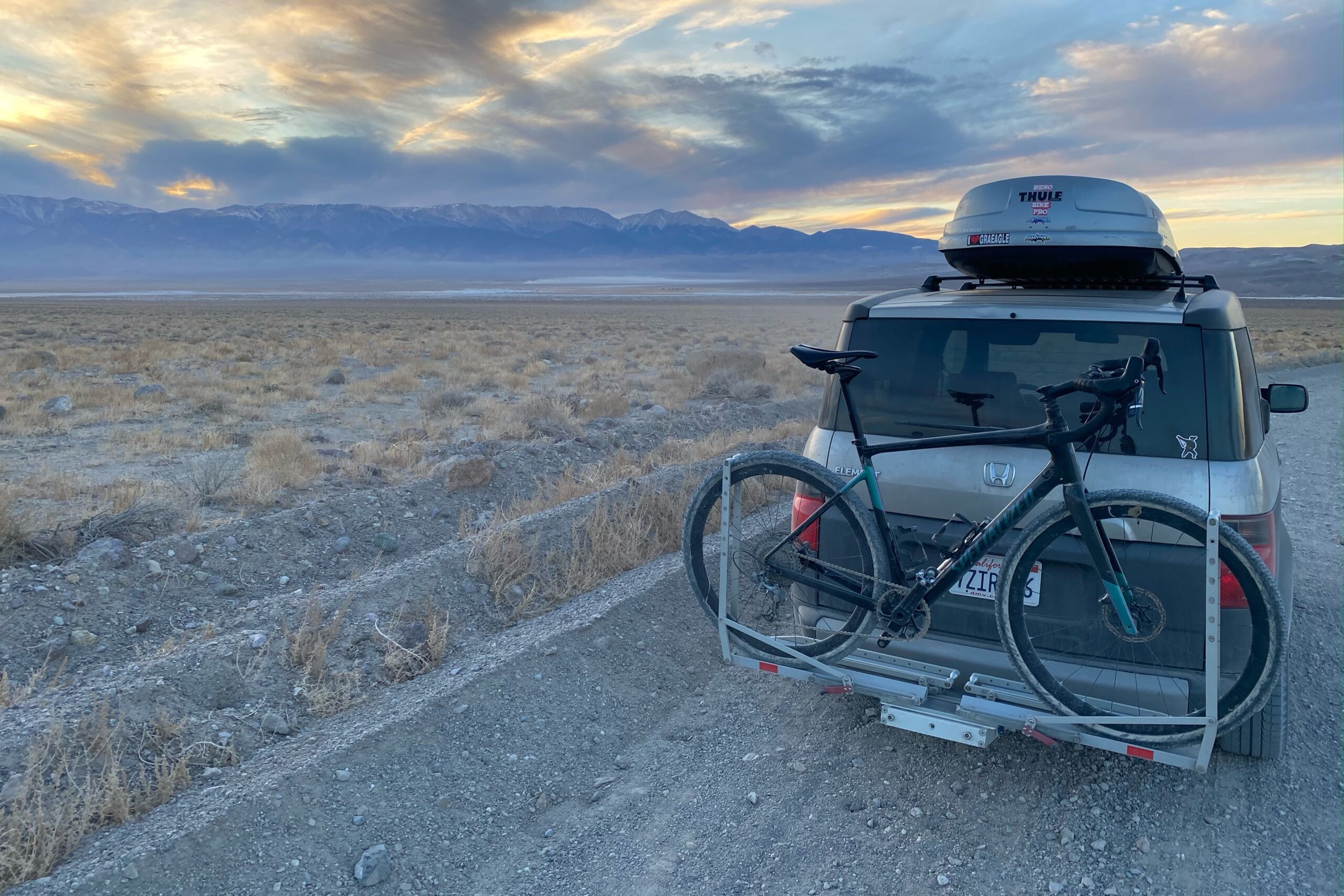 A 1Up USA rack loaded with a gravel bike in the desert
A 1Up USA rack loaded with a gravel bike in the desert
Tray racks like the 1Up USA Heavy Duty Double have dual clamp arms that only make contact with your tires. (photo/Fred Stamm)
Tray Racks
Most tray racks, though not all, avoid frame contact by securing bikes with either a front wheel clamp and rear wheel strap, or dual clamp arms that grip the tires. Front wheel clamping models, such as the Thule T2 Pro XTR, Rocky Mounts MonoRail, Kuat NV 2.0, and Yakima StageTwo, use hook-shaped ratcheting arms to secure the front wheel and straps for the rear wheel. While avoiding frame contact, the front wheel hook may potentially rub against the fork, causing minor abrasion over time, and rear wheel straps can sometimes scuff rims. Dual clamp models, like the 1Up USA Heavy Duty Double, Kuat Piston Pro X, and Rocky Mounts GuideRail, secure bikes solely by the tires, completely eliminating frame, fork, or rim contact.
Vertical Carry Racks
Vertical carry racks employ various bike attachment methods, including fork crown, front wheel, and handlebar support systems. Front wheel basket/cradle models, like the VelociRAX and 1Up Recon, minimize bike contact, typically only touching the front tire and using straps for rear wheel securement. Fork crown carry models, such as North Shore Racks and Yakima HangOver, use padded cradles that contact the fork crown and head tube bottom, potentially causing paint abrasion in these areas. Handlebar support vertical racks offer greater versatility than fork-carry models but may also cause minor abrasion to handlebar finishes.
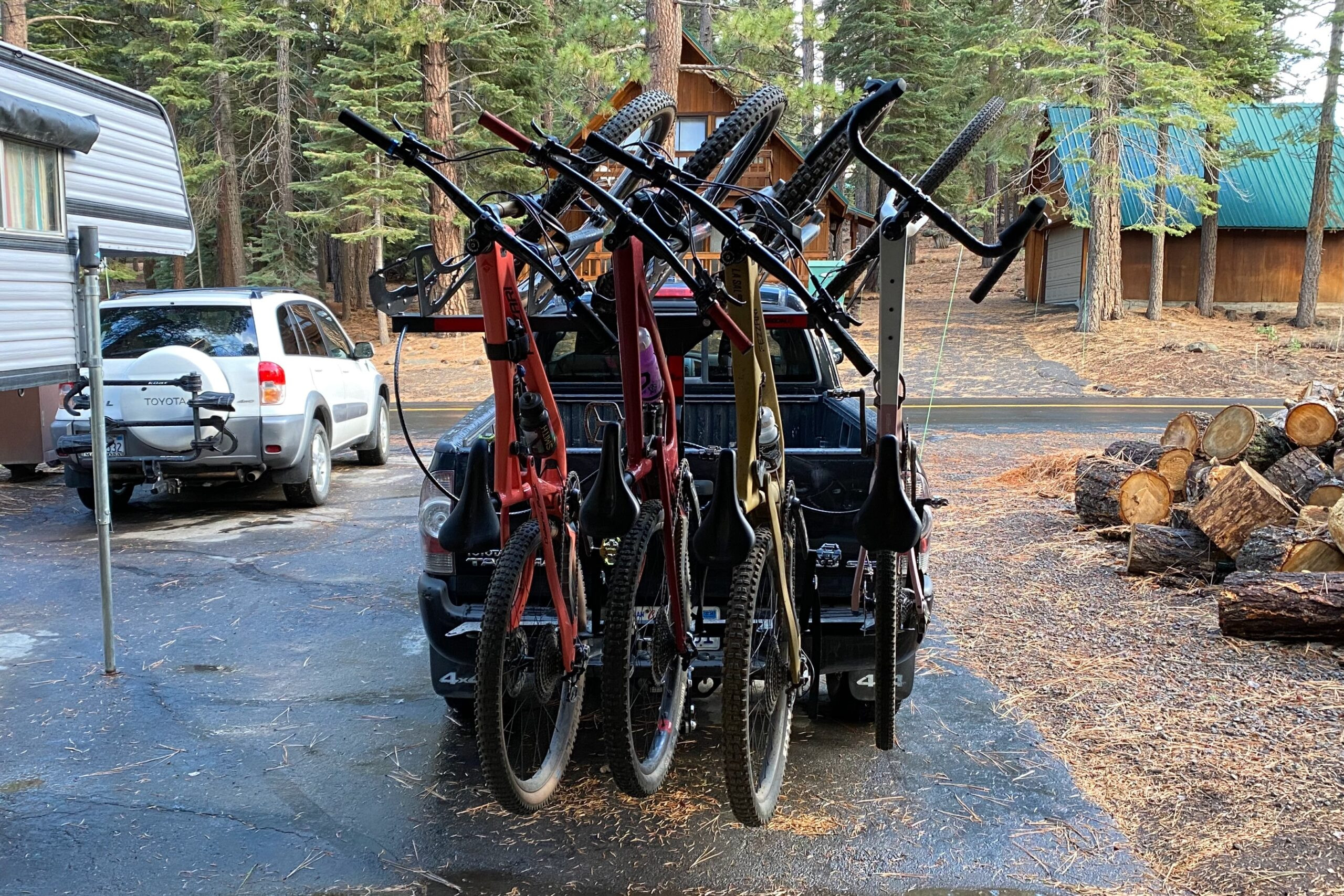 the 1Up Recon 5 loaded with 4 bikes
the 1Up Recon 5 loaded with 4 bikes
If you need to carry lots of bikes, the vertical carry style is the way to go. (photo/Jeremy Benson)
What Kind of Bikes Do You Have?
Beyond bike count and weight, the types of bikes you own are crucial to consider. While hitch racks are generally versatile, not all are compatible with every bike. Some racks are designed to work with nearly any bike, accommodating a wide range of wheel sizes, tire widths, and wheelbases, while others are more limited. Carefully consider these factors to select a rack best suited to your specific bikes.
Tray racks are generally the most versatile in terms of bike fit, accommodating a wide range of wheel sizes and tire types, from narrow road bike tires to mountain bike treads. Many models can handle fat bikes up to 5 inches wide, although some require fat bike kits. Wheelbase length can be a limiting factor for some tray racks, so consider this if you own longer downhill or enduro bikes.
Vertical carry racks vary in versatility depending on their bike support system. Fork crown models are limited to mountain bikes with suspension forks. Front wheel basket or handlebar support models accommodate a wider range of bikes, including rigid fork and drop handlebar bikes.
Top tube hanging racks are the least versatile due to their bike support method. Adult-size frames with straight top tubes work best. Curved tubes, small frames, or full suspension bikes can be challenging or impossible to fit properly, often requiring adapters.
 A 2-inch hitch receiver
A 2-inch hitch receiver
Hitch receivers come in either 1.25″ or 2″ (pictured). Getting a rack that fits your receiver is an important piece of the rack puzzle. (photo/Jeremy Benson)
What Size Is Your Hitch Receiver?
Selecting a bike rack that matches your vehicle’s hitch receiver size is critical. Many vehicles come with hitch receivers, either 2” or 1.25”. Measure the receiver opening width to determine the size if unsure. If your vehicle lacks a hitch receiver, aftermarket installation is possible at auto shops or U-Haul locations, or DIY kits are available online.
For new hitch installations, we recommend the 2” size due to its increased strength and weight capacity, making it better suited for tray racks with add-ons, swing-away attachments, or vertical hanging racks. 1.25” receivers are adequate but have lower weight ratings, and some racks are only offered in 2” size. Adapters exist to bridge between sizes, and some racks feature adjustable receiver ends.
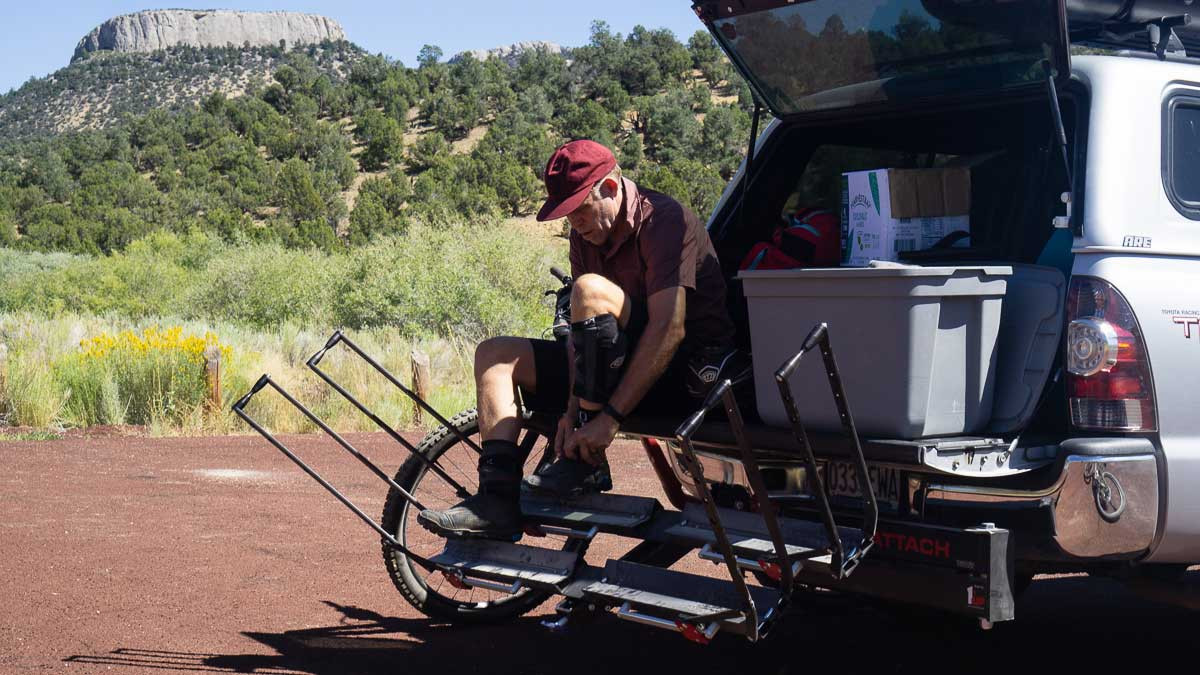 A 1Up USA rack tilted down to allow access to the rear of the vehicle
A 1Up USA rack tilted down to allow access to the rear of the vehicle
Tilt features are fairly standard and allow you to open truck tailgates or the rear doors of wagons, hatchbacks, and SUVs. (photo/Steve Graepel)
Swing Away and Tilt Features
Most quality tray racks include a tilt function for folding up when not in use, tilting flat for bike transport, and tilting down for rear vehicle access. Some feature convenient tilt-release handles or foot pedals, allowing tilting even when loaded. Others have less user-friendly mechanisms requiring reaching around loaded bikes. Most vertical and top tube hanging racks also offer tilt functionality.
For camper van, cabover camper owners, or those desiring unrestricted rear vehicle access, consider swing-away racks or swing-away attachments. These allow the entire rack to pivot away, facilitating easier access to large doors or trunks. Some racks, like the Rocky Mounts Backstage, integrate this feature, while most manufacturers offer swing-away attachments. These attachments are typically 2” receiver size only and increase rack weight and cost.
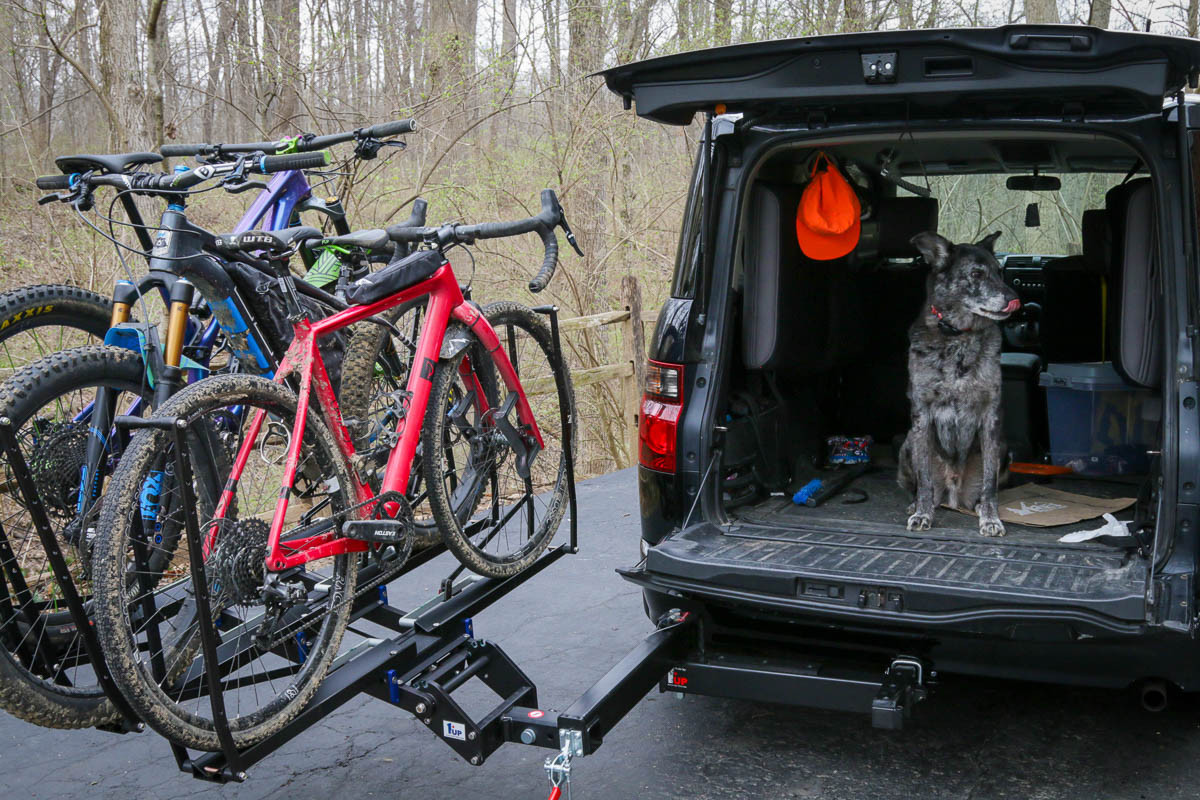 A rack with a swing-away feature to allow access to the rear of the vehicle
A rack with a swing-away feature to allow access to the rear of the vehicle
Swing-away racks allow for easier access to the rear of your vehicle. Attachments like the 1Up RakAttach can be added to your existing rack, and the RockyMounts Backstage comes with the pivoting feature as part of the design. (photo/Zach Overholt)
Vehicle Clearance
Vehicle clearance with the rack and bikes is important. Avoid handlebar contact with rear windows or the need to adjust handlebars for loading. Hitch placement, vehicle style, and bumper/rear door design influence clearance. Some racks fit most vehicles well, while others may have tighter fits, potentially causing handlebar-window/door contact, especially on campervans with vertical rear doors.
Manufacturers often provide technical specs or fit guides online. Kuat’s Piston Pro X Fit Guide is a good example. Compare rack specs to your vehicle measurements to assess fit. Handlebar clearance issues are more common with vertical rear doors. Hitch extensions can improve clearance if needed, and are often offered as aftermarket accessories, sometimes also adjusting rack height. Vertical hanging racks typically have fewer clearance issues due to angle adjustability.
 The semi0integrated cable lock on the Kuat Sherpa 2.0
The semi0integrated cable lock on the Kuat Sherpa 2.0
Included security features like locking hitch pins and cable locks are always appreciated. Some racks’ security features are more robust than others, and we always recommend adding a tough aftermarket lock to keep your bikes safe. (photo/Jeremy Benson)
Security
Bike security is a major concern, given the value of modern bikes. Many racks include integrated cable locks or semi-integrated cable locks as theft deterrents. While convenient, these are often insufficient for robust security. We recommend supplementing with a heavy-duty aftermarket bike lock for enhanced security and peace of mind. Refer to our review of the best bike locks for recommendations.
Rack security is also important, as racks themselves are valuable. Most hitch racks include hitch pin locks or locking knobs to secure them to the vehicle. Some use security Allen keys for tightening or loosening. Hitch pin locks are inexpensive and a worthwhile addition for racks lacking one.
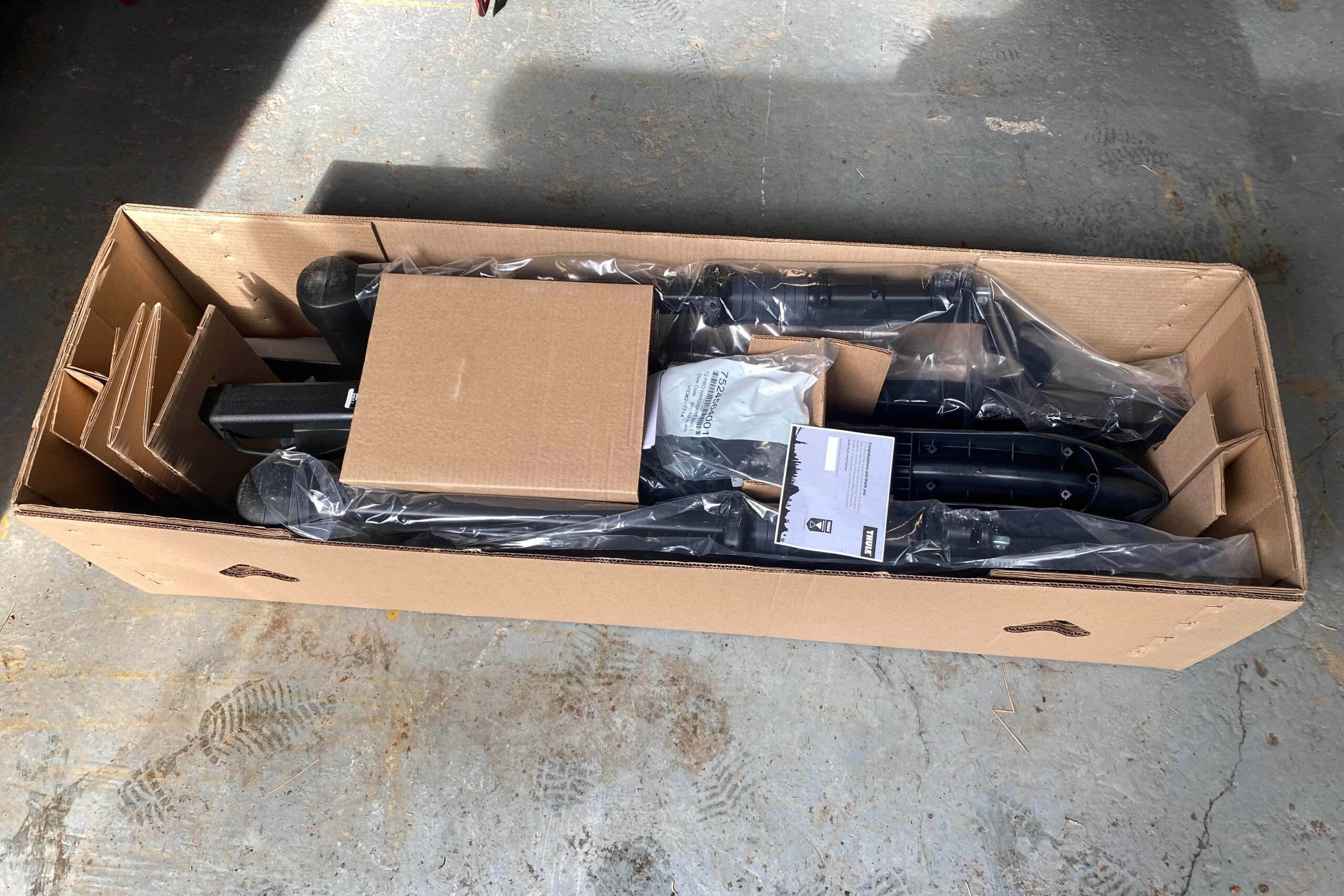 The Thule T2 Pro XTR hitch bike rack before assembly
The Thule T2 Pro XTR hitch bike rack before assembly
Most racks, like the Thule T2 Pro XTR pictured here, are delivered in several pieces with some assembly required to get them ready for use. (photo/Jeremy Benson)
Assembly
Brick-and-mortar retailers often assemble hitch racks upon purchase and may assist with vehicle installation. Online purchases typically arrive boxed, requiring some assembly. Assembly complexity varies, but is generally manageable. Most models include detailed instructions and necessary tools. Instructional videos are often available online or via QR codes. Following instructions precisely simplifies assembly.
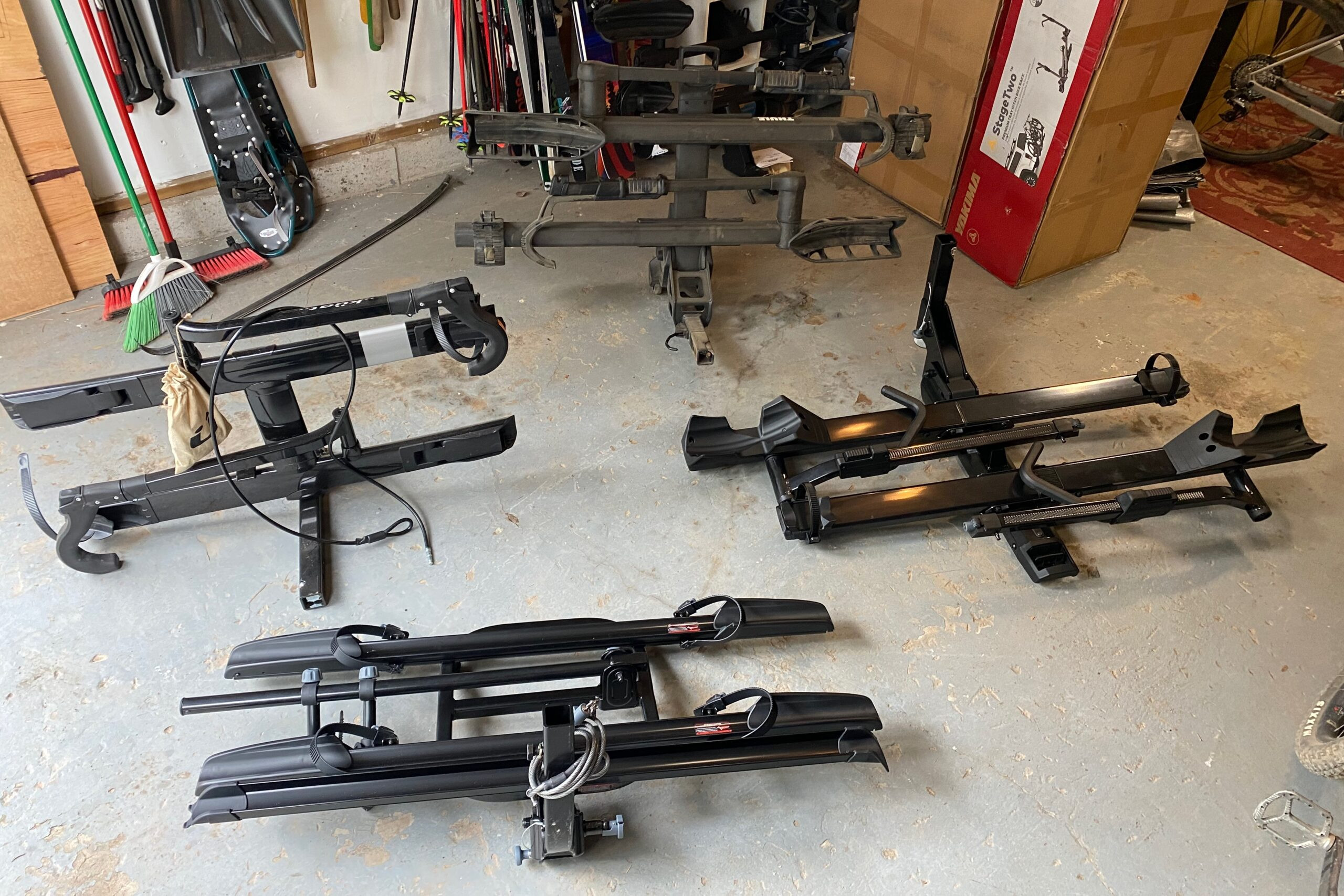 Multiple hitch bike racks on the floor of a garage to demonstrate their sizes
Multiple hitch bike racks on the floor of a garage to demonstrate their sizes
Hitch racks can be big and bulky, so storing them when not in use is certainly a consideration, especially for those short on space. (photo/Jeremy Benson)
Storage
While some leave hitch racks on vehicles year-round, most remove them seasonally or during extended periods of non-use. Hitch racks are generally bulky, requiring significant storage space in garages or sheds. Vertical hanging and tray models are particularly bulky, although some collapse for more compact storage. Wall-mountable hitch docks are available for tidier storage. Top tube hanging racks tend to be the easiest to store due to their narrower folded dimensions.
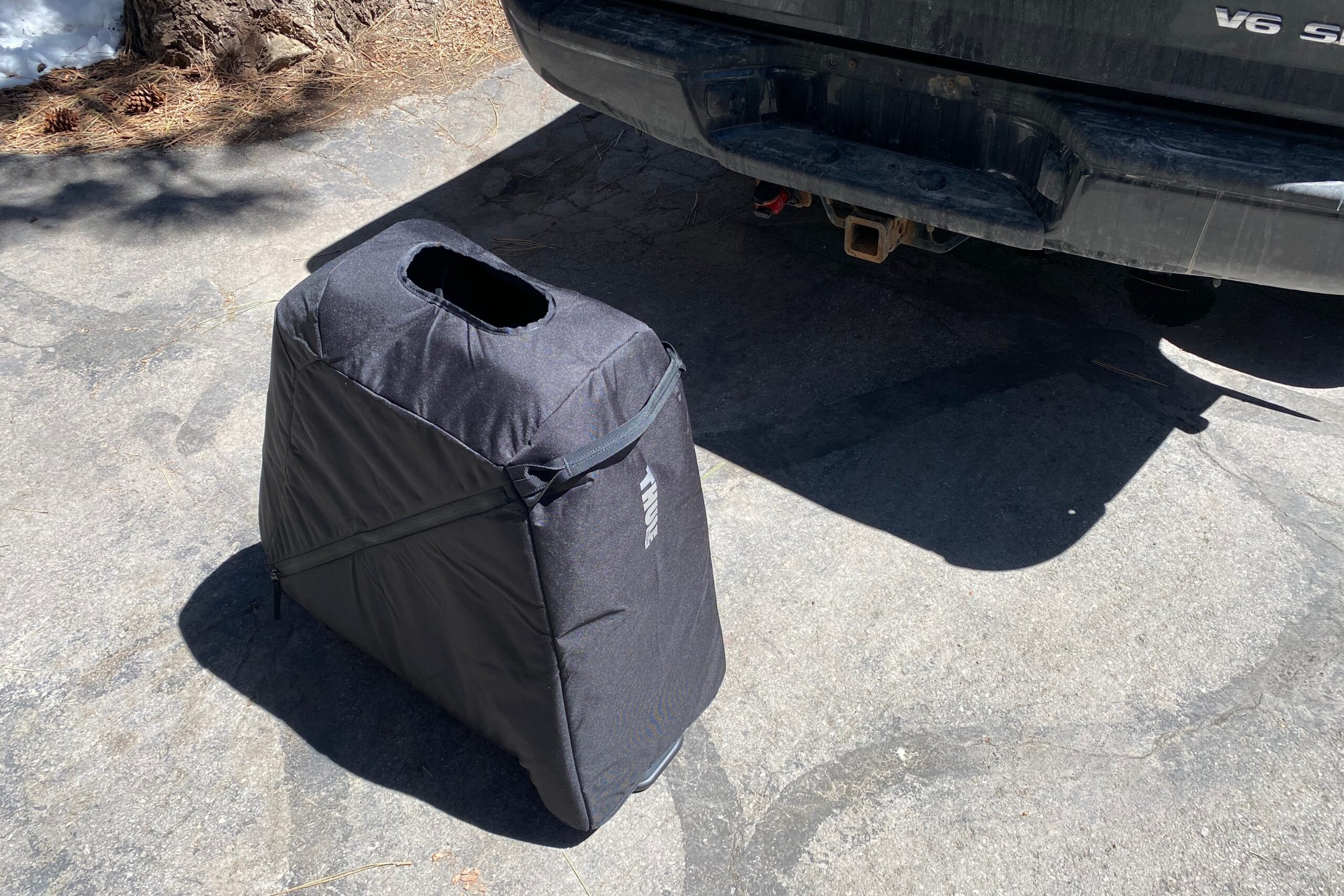 The Thule Epos with the storage cover
The Thule Epos with the storage cover
The Thule Epos is the most compact hitch rack we’ve tested, seen here with the optional storage cover. (photo/Jeremy Benson)
Value
Hitch bike racks are a significant investment, with high-end models exceeding $1,000. While premium racks often offer advanced features and finishes, more affordable models can perform nearly as well for basic bike transport needs. All racks in this guide are superior to not having a rack at all. Tray rack costs increase substantially with add-ons. Vertical hanging racks, while initially expensive, can be more cost-effective for transporting multiple bikes.
Frequently Asked Questions About Hitch Bike Racks
Why should I choose a hitch rack over a trunk or roof rack?
Hitch racks offer several advantages over trunk and roof racks. Hitch racks, when properly installed, minimize contact with the vehicle itself, preventing paint damage often associated with trunk racks. Roof racks require roof bars, either factory or aftermarket.
Hitch racks offer lower loading heights and simpler loading processes, making them more user-friendly. Tray racks require lifting bikes only to tray height. Roof racks require lifting bikes to roof height, which can be awkward. Trunk racks require lifting bikes to support arm height.
Hitch racks are versatile in bike fit, accommodating a wide range of wheel sizes, tire widths, frame shapes, and wheelbases. Hitch racks are gentler on bikes, minimizing bike-on-bike or bike-vehicle contact during transport. Hitch racks also eliminate the risk of garage collisions with bikes on the roof, preventing potential damage to bikes, vehicles, and property.
There are a lot of choices up there, which one is the best?
The “best” rack depends on individual needs. The ideal rack carries the number and type of bikes you own, fits your vehicle, and aligns with your budget. For mountain bike shuttling or carrying 4+ bikes, vertical carry models are ideal. For 1-2 bikes, tray racks are generally the best choice. For heavy e-bikes, prioritize racks with high weight capacities and loading ramp compatibility. If storage space is limited, choose compact or lightweight models. With numerous options available, finding a rack that suits your specific needs is achievable.
Why are hitch bike racks so expensive?
Hitch rack costs reflect extensive testing, premium materials, engineering, and design. Reputable brands invest heavily in research and development, rigorously testing racks for strength, durability, and longevity. They test coatings and hardware against corrosion and harsh elements, ensuring long-term reliability. This rigorous testing and quality construction justify the higher price point compared to less established brands.
Why should I get a name-brand hitch bike rack?
Name-brand hitch racks prioritize bike safety and security during transport. Established brands conduct extensive testing for strength, durability, and longevity, ensuring racks can withstand real-world conditions. They rigorously test coatings and hardware against corrosion and harsh elements. While less expensive, no-name brands may lack this rigorous testing and quality assurance, potentially compromising bike safety and rack longevity.
Can I just leave it on my car all the time?
Leaving a hitch rack on your vehicle is possible, depending on your location and usage patterns. In milder climates with frequent rack use, leaving it on year-round may be convenient. However, in areas with heavy snowfall or during extended periods of non-use, removing the rack and storing it indoors is recommended to protect it from unnecessary wear and tear, particularly from road salt and harsh weather conditions.
While most racks use aluminum frames, hardware and hitch beams are often steel and susceptible to rust over time, especially in coastal or snowy regions. Regular hosing off and storing the rack indoors when not in use can significantly extend its lifespan.
Which size trailer hitch should I get?
If installing a new trailer hitch, we recommend opting for a 2″ receiver if feasible. While 1-1/4″ hitches may be the only option for some smaller cars, 2″ hitches offer greater strength and weight capacity.
For users planning to add rack extensions, carry more than two bikes, or utilize swing-away adapters, a 2″ hitch is essential to handle the increased weight and leverage. 2″ hitches provide greater overall versatility and are recommended for most hitch rack applications.
I don’t have a hitch receiver, where do I get one installed?
In North America, U-Haul is a common provider for trailer hitch installations, offering both hitch installation and wiring harness services. Local mechanics can also typically install trailer hitches. For DIY enthusiasts, trailer hitch kits are available online for most vehicle makes and models, offering a cost-effective self-installation option.
Related Content
[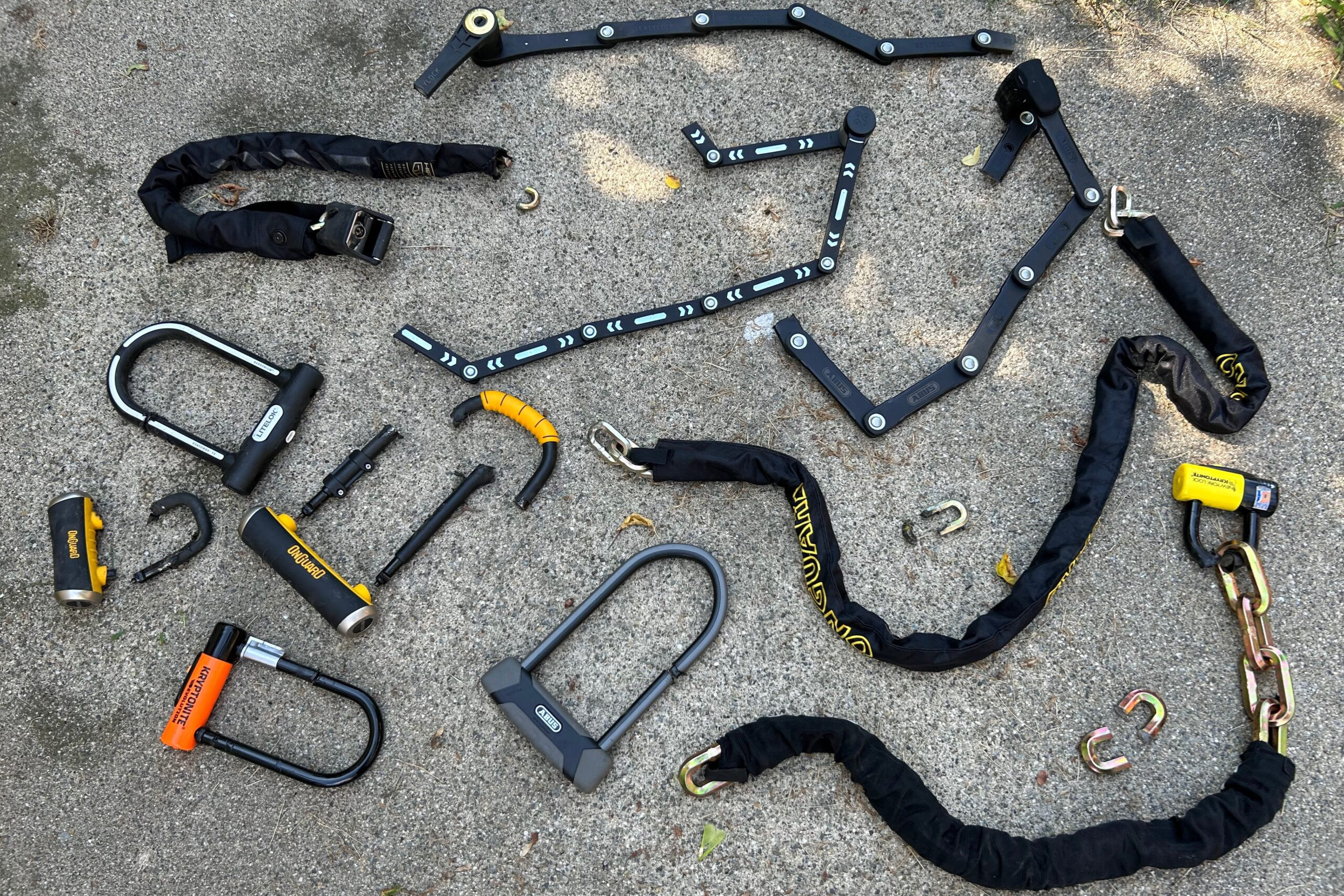{width=2560 height=1707} Buyers Guides
The Best Bike Locks of 2024
If you own a bike of any sort, you should own a bike lock. Bike theft is a common occurrence and looking closely will show…
24 min read

